MEET THE YOUNG ECO-WARRIORS FROM GRENADA | #OPBEACHCLEAN


GRENADA ECO WARRIORS, READY FOR OPERATION BEACH CLEAN
GRENADA, West Indies: Meet Grenada’s eco-warriors of the future situated on the small Caribbean West Indies island of Grenada the students of Mt. Parnassus Junior School will be volunteering with their school assistant Mandy pictured below this April 22nd 2017 for the International Earth Day event hosted by I.A.R.F.A. (Image: Mt. Parnassus Junior School Grenada, image copyright.)
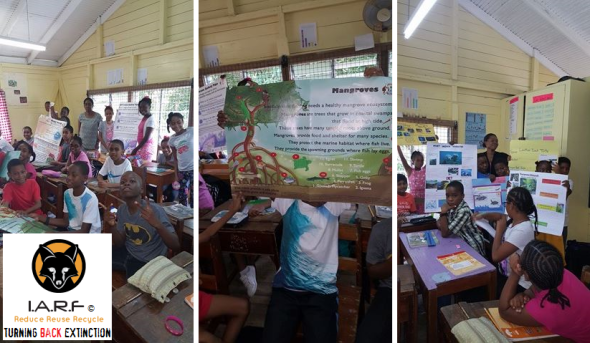
Image: Students presenting their mission for Earth Day 2017, Operation Beach Clean.
Operation Beach Clean hosted by myself this April 22nd 2017 has already attracted people from England, Netherlands, Oman, Viet Nam, Thailand, Australia, Greece, and now children from the West Indies island of Grenada which is excellent news.

Image: Teaching assistant and teacher organizing and hosting the youth beach clean.
The Mt. Parnassus Junior School students will be taking part in the two day event cleaning a large stretch of their native islands coastline of which its expected a lot of plastic and waste will be collected due to the islands strategic geographical point.
Students will be collecting waste, monitoring the highest number of individual marine waste items so environmentalists can approach governments and manufacturers to lobby for changes, for the benefit of both animals and our future human generations too. The whole purpose of these events isn’t just to protect wildlife, but to also preserve our children’s future for years to come.
Furthermore the students of Mt. Parnassus Junior School will document on beach cleanliness, types of micro-plastics located on the beaches, pollution, and the deaths of any species of bird and fish found plus much more. For more information please visit our Facebook forum here.
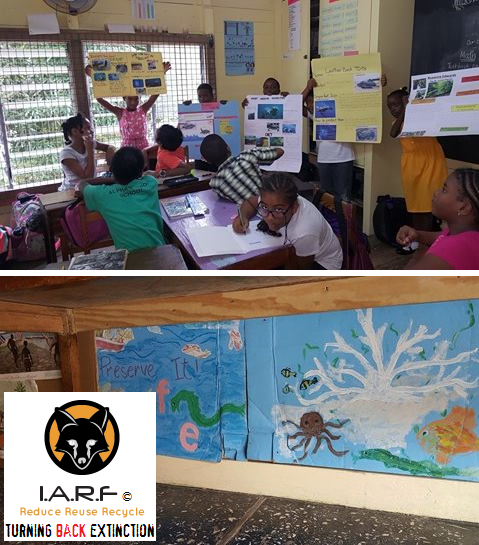
Image: School presentation, Grenada, West indies.
Around 150 bird species are on the island including the Grenada dove – one of the world’s most endangered bird. At the other end of the spectrum is the kite which, in the Caribbean, is widespread. There are a few havens for wildlife in Grenada, including Lake Antoine, Mount Hartman National Park, and the salt pond at the La Sagesse estuary.
To name but a few of the 150 species, birds you might see in Grenada include the limpkin, black-necked stilt, heron, mangrove cuckoo, tern, the common snipe, brown-crested flycatcher, Caribbean coot, northern jacana, three species of hummingbirds, cattle egret, frigatebird, boobies, bananaquit, mockingbird, osprey and the barn owl.
Sea turtles tend to nest at beaches in the north of Grenada, Bathways Beach is a favourite spot from March every year (in the Levera National Park). Giant leatherback turtles, hawksbill turtles, green turtles and, somewhat rarer, loggerhead turtles can be seen in Grenada.
Between the months of December and April in particular sees Grenada’s waters frequented by different whale species, including Orca (Killer) whales, Curvier beaked, humpback and Sperm whales. Around fifteen species in all have been logged which swim in the waters of Grenada. Year-round you can see Pilot, Bryde’s, Sperm, Pygmy and Sei whales. Several different varieties of dolphins can be spotted offshore too.
The large variety of fish in Grenada waters, to name some of them, include the yellow tail snapper, bar jacks, spotted drums, frogfish, scorpion fish, banded jaw fish, pipefish, grey angelfish, horse eye jacks, Atlantic spade fish, grouper, great barracuda, As well as seahorses, stingrays, Moray eels, spotted eagle rays and even Manta rays. For more information please click the link here.
Currently the problems of plastic waste littering the island of Grenada is considered very problematic - and to know these young children will be taking part in such an important international earth day environmental event, and are already eager to make change happen - is fantastic. The youth of Mt. Parnassus Junior School aren’t just setting an example, they are demonstrating their love for their island, flora and fauna - something many adults are still failing to at.
Given the islands’ geological and hydrological conditions, local stakeholders that are working to reduce Grenada’s waste problem expect that most of the plastic bottle litter as well as some of the plastic bottle landfill waste will sooner or later end up in the sea, negatively impacting the islands’ marine ecosystem. Furthermore as I speak nine endemic species of fish and five native birds are already on the verge of complete wild extinction. For more information please view the source here.
I’m so pleased and proud to know that children will be getting involved this April 22nd for the I.A.R.F.A Earth Day Event 2017 - Operation Beach Clean. If you are a school teacher and would like to organize a beach clean to conclude my ten year scientific study on marine and land animal deaths please contact me in person by clicking the link here.
More on the Grenada Beach Clean event will be made public soon. Watch this space.
With much thanks to Mandy, the school children participating, and for everyone that have unselfishly come forward to volunteer their time to clean our oceans on the biggest environmental event of the year.
Thank you.
Dr Jose C. Depre.
Environmental, Botanical and Human Scientist.
WHY IS FLORIDA LOSING SO MANY FISH?


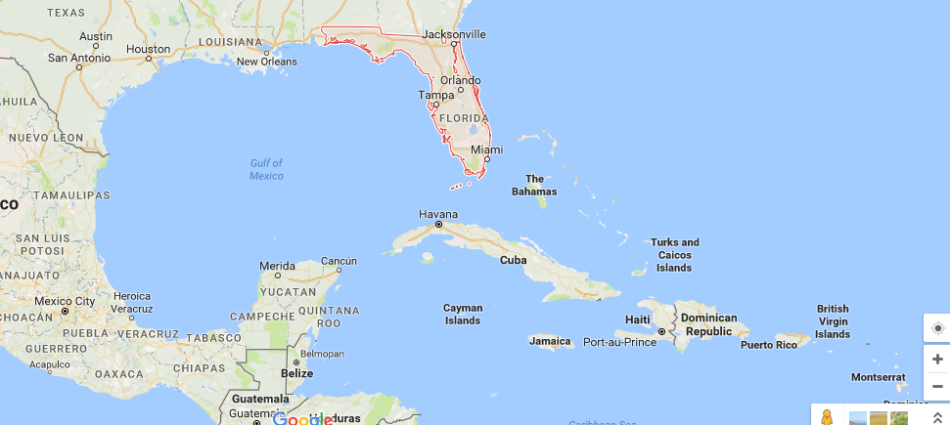
2011-2017. HOW CLEAN ARE AMERICAN WATERS? | AQUATIC DEATH REPORT.
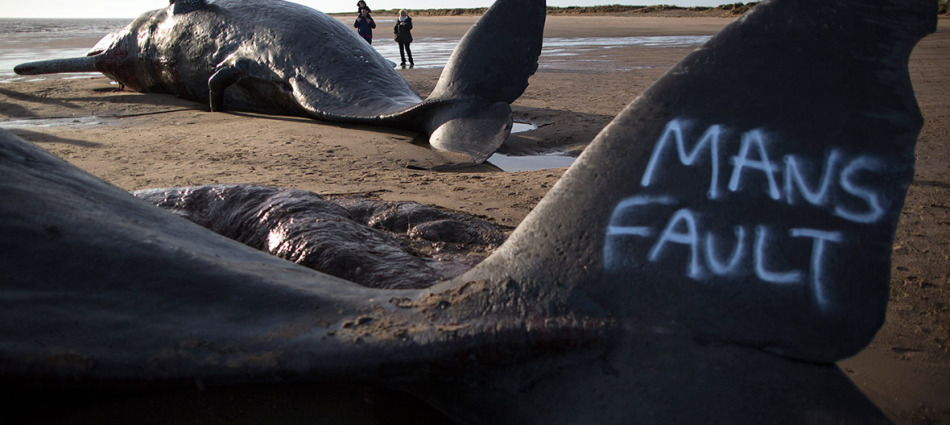

Image: One of numerous Sperm Whales that beached in England.
HOW CLEAN ARE THE UNITED STATES BEACHES, RIVERS AND LAKES?
The United States of America allegedly has a reputation for some of the worlds finest beaches, rivers and lakes. Well that’s what travel agencies want you to hear and read from the U.S. Since 2011 to 2017 in the United States of America there has been hundreds of reported fish, whale, dolphin and marine bird deaths (among other aquatic species.) The situation is now so out of control that should the U.S continue to lose fish at the rates seen below in the report from 2011-2017 larger marine fauna will begin dying of starvation. Extinction will occur!
Starvation has already been reported within some of the reports below relating to walruses, whales and even marine birds. Florida, Texas, California, New York and Missouri are ranking in the top five states to report mass aquatic deaths - Florida being the worst. I’m going to let you the reader be judge and jury of this report, after all it says it all. Each report can also be Googled too for authenticity. Below is a report relating to the state of U.S beaches, the high seas, rivers and lakes, and things aren’t looking too good, that’s for sure. America ranks as the number one country to report mass aquatic deaths than any other country on the planet.
This April, Saturday 22nd 2017 from 09:00am we are organizing an international beach cleaning operation code named (#OpBeachClean.) To get involved please click this Facebook link >here< and contact me in person on Facebook. Your message will be communicated to anyone of my devices and I’ll answer you as soon as possible.
Beach cleans have been organized in Greece, Viet Nam, Thailand, England, Australia, Oman, Netherlands and one in California, U.S. Please help and lets make this beach clean on Earth Day 22nd April a day to remember, not for us, but for our wildlife. Thank you.
2011
1. 1st January 2011 - 5,000+ Red-winged blackbirds & Starlings fall out of the sky dead in Beebe, Arkansas.
2. 1st January 2011 - 200,000+ Dead fish wash up on the shores of Arkansas River, Arkansas.
3. 2,000,000 (2 Million) Dead fish consisting of Menhayden, spots & Croakers wash up in Chesapeake Bay, Maryland & Virginia.
4. 4th January 2011 - Thousands of dead fish consisting of Mullet, Ladyfish, Catfish & Snook in Volusia County, Florida.
5. 4th January 2011 - 3,000+ dead Blackbirds found in Louisville, Kentucky.
6. 4th January 2011 - 500 Dead Red-winged blackbirds & Starlings in Louisiana.
7. 6th January 2011 - Hundreds of dead Grackles, Sparrows & Pigeons were found dead in Upshur County, Texas.
8. 14th January 2011 - 300 Blackbirds found dead on highway I-65 south of Athens in Alabama.
9. 21st January 2011 - Thousands of fish dead in Detroit River, Michigan.
10. 27th January 2011 - 200 Pelicans wash up dead on Topsail Beach in North Carolina.
11. 9th February 2011 - Thousands of dead fish wash ashore in Florida.
12. 11th February 2011 - Hundreds of dead birds found in Lake Charles, Louisiana.
13. 21st February 2011 - Big Freeze kills hundreds of thousands of fish along coast in Texas.
14. 23rd February 2011 - 28 baby Dolphins wash up dead in Alabama and Mississippi.
15. 8th March 2011 - Millions of dead fish in King Harbor Marina in California.
16. 28th March 2011 - Sei Whale washes up dead on beach in Virginia. [NB: Death toll never provided.]
17. 29th March 2011 - Over 1300 ducks die in Houston Minnesota.
18. 18th April 2011 - Hundreds of dead fish found in Ventura Harbour in Southern California.
19. 20th April 2011 - 6 Tons of dead Sardines found in Ventura Harbour in Southern California.
20. 22nd April 2011 - Leopard Sharks dying in San Francisco Bay.
21. 13th May 2011 - Dozens of Sharks washing up dead in California.
22. 13th May 2011 - Thousands of fish wash up dead on shores of Lake Erie in Ohio.
23. 17th June 2011 - About 750 fish found dead in River Des Peres in Missouri.
24. 28th June 2011 - 30 Dolphins wash up dead in the LowCountry, USA.
25. 29th June 2011 - Hundreds of fish turn up dead in South Georgia.
26. 9th July 2011 - Two 1000-pound Whales found dead on beaches in Indian River County, US.
27. 14th July 2011 - Large Quantities of large and small fish continue to wash up dead in Oklahoma.
28. 21st July 2011 - Lake full of dead fish in Louisiana.
29. 22nd July 2011 - Fish washing up dead on shores of North Falmouth, USA.
30. 1st August 2011 - Thousands of Fish die in Lake that turned blood red, in Texas. [NB: The blood red could have something to do with red algae blooms, the reports are sketchy.]
31. 1st August 2011 - Hundreds of Fish dead in Rio Grande River, New Mexico.
32. 14th August 2011 - Hundreds of Fish and Turtles dead in Pearl River, Louisiana.
33. 19th August 2011 - Dead Dolphins and Seals found on Oxnard Beach, in California.
34. During the month of August 2011 2 whales of unknown origin washed ashore in the U.S.
35. 17th September 2011 - Up to 400 Squid wash up dead on Blacks Beach in San Diego.
36. 20th September 2011 - Thousands of white bass turn up dead in Arkansas River in America.
37. 22nd September 2011 - Hundreds of Giant Squid Washing Ashore Dead on Orange County Beaches in America.
38. During the month of September 2011 2 whales of unknown origin washed ashore within the United States. [NB: Reports are sketchy, and the USFWS refuse to acknowledge my concerns.]
39. 21st October 2011 - Hundreds (Maybe Thousands) of dead fish along Briar Creek in Georgia.
40. 24th October 2011 - Thousands of dead fish in Little Wabash River in Illinois.
41. 28th October 2011 - 3 more Dolphins found dead in Mississippi. (14 Dead this month.)
42. 31st October 2011 - Oyster Die-off in Pensacola in America.
43. 31st October 2011 - 500 Songbirds dead in West Virginia in America.
44. During the month of October 2011 five whales stranded in the U.S of unknown origin. (NB: Reports are sketchy although confirmed.]
45. 2nd November 2011 - MILLIONS of fish killed by “Red Tide” along Texas coast in America.
46. 11th November 2011 - Massive Fish Kill in Lake Poway in California.
47. 17th November 2011 - Fish Kill affecting two miles of a creek in Western Iowa in America.
48. 27th November 2011 - Five Dolphins wash up dead in Mississippi.
49. During the month of November 2011 some 15 whales stranded in the U.S.
50. 15th December 2011 - Thousands of Birds die from “crash landing” in Utah.
51. 20th December 2011 - 400 Birds found dead in Davis County in USA.
52. 27th December 2011 - “Red Tide” killing fish in Florida.
2012
1. 1st January 2012 - 200 Blackbirds found dead in Arkansas USA.
2. 7th January 2012 - Thousands of Fish found dead in California.
3. 9th January 2012 - Dozens of Turtles found dead in Florida.
4. 14th January 2012 - 30 Dolphins beach, 20 dead in Cape Cod in America.
5. 85 Dolphins beached, 61 dead in Cape Cod in America.
6. 27th January 2012 - 12 Dolphins wash up dead in Louisiana.
7. 3rd February 2012 - 1,000 Fish found dead floating in two ponds in Virginia.
8. 3rd February 2012 - 100 Pigeons found dead in South Dakota.
9. 7th February 2012 - Dozens of dead Birds found on beach in Florida.
10. 14th February 2012 - UPDATE: 124 Dolphins have now beached and died in Cape Cod America. [[ SCROLL THROUGH ALL OTHER REPORTS PUBLISHED AND REVIEW THE PATTERNS HERE RELATING TO WHALE DEATHS AND THE MONTHS OF JAN, FEB AND MAR.]
11. 15th February 2012 - 100 dead birds found along highway in Maryland America.
12. During 2011 - Record number (335) of Sea Otters either found dead or ill along California coast in America.
13. 2nd March 2012 - Thousands of Jellyfish wash ashore in Texas.
14. 9th March 2012 - Dozens of birds drop dead in University grounds in Florida.
15. 20th March 2012 - Thousands of dead Fish found in River in Minnesota.
16. 29th March 2012 - 10,000 Geese and Waterfowl dead in Siskiyou County America. [NB: C.O.D never found.]
17. 30th March 2012 - Hundreds of Birds Killed in Hail storm in Texas.
18. 11th April 2012 - 14,000 Fish dead in Creek in Missouri.
19. 17th April 2012 - Thousands of fish (30 species) dead in a creek in Tennesse.
20. 25th April 2012 - 28,000 dead Fish found in River in Strongsville, America.
21. 25th April 2012 - 11,000 dead Fish found in River in Kettering, America.
22. 27th April 2012 - Mass Fish kill on Lake Elsinore in California.
23. 30th April 2012 - Hundreds of Bull RedFish found dead in Alabama.
24. 3rd May 2012 - Dead Fish are washing up on shore of Lake Houston in America.
25. 6th May 2012 - Mass Fish death found in Heritage Park Pond in Massachusetts.
26. 8th May 2012 - Hundreds of dead fish in Brake Lake, Perry County America.
27. 16th May 2012 - Fish kill in Arcadia Lake in Oklahoma.
28. 20th May 2012 - Hundreds of Fish found dead at Clear Lake in Minnesota.
29. 23rd May 2012 - 60,000 - 100,000 dead Fish in three Creeks in Maryland USA
30. 24th May 2012 - Hundreds of Fish found dead in Briar Creek in North Carolina.
31. 27th May 2012 - Entire Fish Farm stock to be killed after virus found for first time in waters of Washington State.
32. 29th May 2012 - Mass Fish death - 13,000 Fish found in Ohatchee Alabama.
33. 30th May 2012 - Thousands more Fish turning up dead in Maryland.
34. 5th June 2012 - Thousands of Dead fish found in Imperial Lakes in Florida.
35. 6th June 2012 - Over 10,000 dead Carp found in Blue Springs Lake, Missouri.
36. 120 Dolphins that died off Texas coast between November and March declared “unusual mortality event” America.
37. 20th June 2012 - Hundreds to Thousands of fish washing ashore dead on Sutherland Reservoir Nebraska.
38. 21st June 2012 - 150 Birds washing up dead or dying on East Florida beaches in America.
39. 21st June 2012 - Dead turtles washing ashore along Delaware and New Jersey coasts, scientists not sure why in America.
40. 22nd June 2012 - Fish kill on Lake Odessa in Louisa County America.
41. 23rd June 2012 - 67 Birds found dead at Kanaha Pond Wildlife Sanctuary Hawaii.
42. 25th June 2012 - Several thousand fish dead in a lake in Georgia America
43. 26th June 2012 - Fish kill in Wisconsin Counties in America.
44. 28th June 2012 - Fish die-off in Platte River in Nebraska.
45. 2nd July 2012 - 10,000 Fish dead in South Knoxville Pond in Tennessee America.
46. 3rd July 2012 - 2,300 dead Fish washed ashore on South River in Butts County, Georgia America.
47. 3rd July 2012 - Fish Kill: Catfish die-off on Lake Buffum near Fort Meade Florida.
48. 3rd July 2012 - Hundreds of Fish found floating dead in Upstate Lake South Carolina.
49. 3rd July 2012 - Major Fish kill: Hundreds of thousands of Fish dead in Lake Wichita Texas.
50. 4th July 2012 - Thousands of Fish found dead on Dexter City Lake in Missouri America.
51. 5th July 2012 - Over 20 dead Birds (Egrets) found in Rockport Texas.
52. 5th July 2012 - Thousands of Fish found dead in James River in Lamoure North Dakota.
53. 5th July 2012 - Fish kill on Roy Lake in South Dakota.
54. 5th July 2012 - Fish kill on Century Village Lakes in Florida.
55. 6th July 2012 - Fish kill in Patoka River, Indiana.
56. 6th July 2012 - Mass Fish kill on Salt River in Arizona.
57. 6th July 2012 - Many thousands of dead Fish found in Silver Lake, Delaware America.
58. 7th July 2012 - Over 50 Ducks and Geese found dead in Ohio, leaving locals baffled, America.
59. 9th July 2012 - “Catastrophic” Fish kill on Geneva Lake, also over 200 Pike dead on Fountain Lake in Minnesota America.
60. 10th July 2012 - Lobster mass die-off continues in Connecticut America.
61. 10th July 2012 - Dozens of dead Birds found in Illinois America.
62. 11th July 2012 - 19,000 Fish dead in Lake Odessa America.
63. 11th July 2012 - 58,000 Fish kill on the Des Moines River in Iowa America.
64. 12th July 2012 - Thousand of dead fish found on the Vermilion River in Illinois America.
65. 12th July 2012 - 6,500 dead Fish in Twin Lakes in North Carolina America.
66. 12th July 2012 - Tens of thousands of Fish dying and many birds dying to in Horicon Marsh America.
67. 17th July 2012 - MILLIONS of “weird”, and “unknown” Crab like creatures wash onto beaches, either dead or dying in Hawaii.
68. 19th July 2012 - Hundreds of Frogs found dead in Chesterfield Lake, Missouri, America.
69. 20th July 2012 - Thousands of dead Fish line beaches in Piney Point, Maryland, America.
70. 20th July 2012 - 300 Birds found dead on Agate Beach in Oregon, America.
71. 21st July 2012 - Thousands of fish washing ashore dead on Lake Elsinore in California, America.
72. 22nd July 2012 - Massive Fish kill on Lake Erie in Ohio, America.
73. 23rd July 2012 - Thousands of dead Fish wash ashore on Volusia’s beaches, Daytona, America.
74. 23rd July 2012 - Fish kill found on Big Sandy Lake in Minnesota, America.
75. 26th July 2012 - Fish kill in a canal in Plantation, Florida, America.
76. 29th July 2012 - Thousands of dead Fish found in the Colorado River, America.
77. 3rd August 2012 - Massive Fish kills right across America.
78. 3rd August 2012 - Massive Bird kill on beaches of Bandon, Oregon, America.
79. 3rd August 2012 - 3,000 Fish found dead on Petit Jean River in Arkansas, America.
80. 5th August 2012 - 40,000 Sturgeon and thousands of other Fish dead in Iowa and other Central States in America.
81. 7th August 2012 - Large Fish kill on the Neuse River in North Carolina, America.
82. 7th August 2012 - 900 Birds found dead in Minnesota, America.
83. 9th August 2012 - 20,000 dead Fish in Lake Contrary, Missouri, America.
84. 9th August 2012 - Hundreds of Crabs washing ashore dead on Tiana and Shinnecock Bay in America.
85. 13th August 2012 - Hundreds of Thousands of dead Fish on beaches from Matagorda to Galveston, Texas.
86. 15th August 2012 - Dozens of Birds fall from sky dead in New Jersey, America.
87. 15th August 2012 - 5,000 Fish found dead in Sugar Creek, Ohio, America.
88. 16th August 2012 - Fish kill in Wolf Creek, Iowa, America.
89. 17th August 2012 - Lots of various Fish and Stingrays washing up dead off Myrtle Beach in South Carolina, America.
90. 17th August 2012 - 1 MILLION Fish have been killed by “red tide” in Texas, America.
91. 20th August 2012 - 20,000 Fish found dead in Contraband Bayou, Louisiana, America.
92. 20th August 2012 - Fish kill in Highland Park in Texas, America.
93. 20th August 2012 - Thousands of Fish continue to die in Neuse River in North Carolina, America.
94. 20th August 2012 - Major Fish kill on the shores of Anson Lake, Texas, America.
95. 22nd August 2012 - Thousands of dead Fish found in Cuyahoga River, Ohio, America.
96. 30th August 2012 - “Significant” fish kill on Tuscarawas River in NEW PHILADELPHIA, America.
96. 30th August 2012 - Die-off of Whitefish in Eastern Idaho Rivers a “mystery”, America.
97. 2nd September 2012 - 17 Whales dead after 22 beach themselves in Florida, America.
98. 4th September 2012 - Thousands of dead Fish found in Broadkill River - “The River smelled like dead fish” - in Delaware, America.
99. 4th September 2012 - Fish kill in Bayou Casotte in Jackson County, America.
100. 4th September 2012 - Thousands of dead Fish along Bayou Lafourche in Louisiana, America.
101. 5th September 2012 - Tens of thousands of Nutria Rats washed up dead on Mississippi beaches in America.
102. 5th September 2012 - Large Fish kills reported around Louisiana in America.
103. 8th September 2012 - Fish kill in San Carlos Lake in Arizona, America.
104. 10th September 2012 - Hundreds of dead Fish litter Lake Vista in New Orleans, America.
105. 12th September 2012 - MILLIONS of dead fish in the Salton Sea in California, America.
106. 12th September 2012 - Thousands of dead Fish in Arrowhead Lakes, Arizona, America.
107. 12th September 2012 - Large Fish kill from New Smyrna Beach to Oak Hill, Florida, America.
108. 14th September 2012 - Hundreds of dead Fish found in a creak in Arlington, America.
109. 14th September 2012 - 131,000 Fish killed due to disease in New York State, America.
110. 17th September 2012 - Mass Fish kill in Lakeview Park, Corpus Christi in America.
111. 19th September 2012 - Large Fish kill in Lake Auburn, Maine, America.
112. 23rd September 2012 - Last remaining 20 Ducks found dead in Arden Park - No Ducks left, Arizona, America.
113. 24th September 2012 - Large Fish kill, causing complete wipeout of Fish in North Sterling Reservoir, Colorado, America.
114. 25th September 2012 - Hundreds of Fish found dead in the Neuse River, North Carolina, America.
115. 28th September 2012 - Ongoing Fish kill caused by algea at Roosevelt Lake, Arizona, America.
116. 28th September 2012 - Massive Fish kill in Harvey’s Run River, Pennsylvania in America.
117. 4th October 2012 - Fish kill caused by “Red Tide” on Sarasota Beaches, Florida in America.
118. 7th October 2012 - 150 dead Birds found in Chicago during September. A 50 Percent increase over August. America.
119. 9th October 2012 - Massive Fish kills caused by Red Tide along Florida coast, America.
120. 12th October 2012 - Mass death of Hammerhead Shark pups found in Hawaii.
121. 16th October 2012 - Fish kill in Dalton Creek, Georgia, America.
122. 17th October 2012 - “Significant” Bass die-off, thousands dead in Dickinson County lakes, Iowa, America.
123. 17th October 2012 - Fish die-off could be in the MILLIONS in Neuse River, North Carolina, America.
124. 19th October 2012 - A Virus is killing Doves all across the Permian Basin, America.
125. 22nd October 2012 - Tens of thousands of Gizzard Shad Fish dead in Oneida Lake, New York State, America.
126. 22nd October 2012 - Thousands of dead Fish scattered along Collier beaches in Florida, America.
127. 23rd October 2012 - Massive Scallop die-off from Red Tide in America.
128. 25th October 2012 - 900+ dead Birds wash ashore on Sleeping Bear Dunes National Lakeshore, Michigan, America.
129. 26th October 2012 - Fish kill in Prairie Creek, Blairstown, America.
130. 31st October 2012 - 15,000+ Fish found dead on Lake Madeline in Texas, America.
131. 4th November 2012 - 700 Waterbirds found dead along shore of Lake Michigan in America.
132. 7th November 2012 - Fish kill found along a 7 mile stretch of Bradford Branch in Ohio, America.
133. 8th November 2012 - Die-off of spawning Salmon in Longfellow Creek, Seattle, America.
134. 16th November 2012 - Thousands of dead gizzard shad Fish found dead on Lake Erie in New York, America.
135. 20th November 2012 - 100 dead starlings found on road baffles scientists in Missouri, America.
136. 24th November 2012 - 26 Turtles die from disease during past few months in West Virginia, America.
137. 1st December 2012 - Catfish die-off near Marco Island in Florida, America.
138. 2nd December 2012 - 50 birds found dead on road in Collin County, Texas, America.
139. 3rd December 2012 - Hundreds of dead Carp washed up in Pinto Lake, California, America.
140. 6th December 2012 - Thousands of Fish found dead and dying on Kiawah Island, South Carolina, America.
141. 11th December 2012 - “Dead Fish all over the place” near giant sinkhole in Louisiana, America.
142. 11th December 2012 - Thousands of Squid wash ashore dead in California, America.
143. 12th December 2012 - 6 Dolphins wash ashore dead during past month in Gavelston, Texas, America.
144. 18th December 2012 - Die-off of Songbirds in Sonoma County, California, America.
145. 27th December 2012 - Thousands of dead Fish washing ashore in Sarasota and Charlotte, America.
146. 31st December 2012 - 300 Birds drop dead out of the sky in Tennessee, America.
2013
1. 4th January 2013 - Thousands of dead Sardines washing ashore on Sanibel Island, Florida, America.
2. 4th January 2013 - Mass Fish kill in the Boca Grande Causeway, Florida, America.
3. 4th January 2013 - Several thousand dead Fish found along the shores of Altus-Lugert Lake, Oklahoma, America.
5. 11th January 2013 - Hundreds of thousands of dead Fish washed up on Masonboro Island in America.
6. 11th January 2013 - Thousands of dead Birds are washing up on Michigan’s shoreline in America.
7. 15th January 2013 - Thousands of dead Fish washed up on Pawleys Island, in South Carolina, America.
8. 15th January 2013 - 30+ Birds found dead in Duson, Louisiana, America.
9. 16th January 2013 - 2,000 Fish found dead in Grand Island Lake, Nebraska, America.
10. 17th January 2013 - 40,000 dead Fish wash ashore for 2nd time in a week in South Carolina, America.
11. 17th January 2013 - Countless number of dead Fish wash ashore on Siesta Public Beach, Florida, America.
12. 18th January 2013 - Thousands of dead Fish continue to wash ashore on Sarasota beaches in Florida, America.
13. 21st January 2013 - Fish kill on the shores of Anna Maria Island in America.
14. 30th January 2013 - Fish kill caused by algae bloom at Possum Kingdom Lake, Texas, America.
15. 30th January 2013 - 1 whale died, location is unknown.
16. 6th February 2013 - Thousands of Tilapia Fish found dead in Tempe Town Lake, Arizona, America.
17. 12th February 2013 - Thousands of Fish killed by chlorinated water in San Mateo Creek, California, America.
18. 14th February 2013 - Thousands of Fish found dead in Suck’s Lake, Nebraska, America.
19. 14th February 2013 - Thousands of dead Lobsters, Starfish, Clams and Skates wash ashore in Massachusetts, America.
20. 24th February 2013 - Thousands of Fish found dead in Cuyahoga River, Ohio, America.
21. 27th February 2013 - Thousands of Fish wash up dead onto beaches in Florida, America.
22. 28th February 2013 - 100 Manatees killed by Red tide this year in Florida, America.
23. 28th February 2013 - 150 Birds found dead in Arlington, Texas, America.
24. During the month of February 2013 a 5 sperm whales washed ashore in American waters, locations again are unknown.
25. 1st March 2013 - 1 Million fish dead so far this year in Lake Erie, America.
26. 6th March 2013 - Dead Fish litter the Payette River in Idaho, America.
27. 6th March 2013 - Fish kill in Baffin Bay has Scientists concerned, Texas, America.
28. 11th March 2013 - Fish kill at Walborn Reservoir in Ohio, America.
29. 12th March 2013 - Fish kill including dead Ducks along Union Ship Canal, New York, America.
30. 13th March 2013 - Hundreds of dead Fish found in Stansbury Park Lake, Utah, America.
31. 14th March 2013 - 100+ Pelicans dead during past 2 months “baffling biologists” in Florida, America.
32. 20th March 2013 - Fish kill on the Brazos River in Texas, America.
33. 21st March 2013 - Hundreds of Fish found dead after Bleach spill in Rocky Creek, Augusta, America.
34. 26th March 2013 - Many Fish kills reported along the Mississippi River, America.
35. 28th March 2013 - 213 Manatees dead so far this year in Florida, America.
36. During March, 23 Whales and Dolphins washed up dead in various countries around the World. 5 of them in America.
37. 1st April 2013 - High number of deaths of Sea Lion pups washing up in California, America.
38. 3rd April 2013 - Hundreds of dead Fish found floating along Rock River in Illinois, America.
39. 3rd April 2013 - Thousands of Fish wash up dead on Lake Erie shores in Buffalo, America.
40. 4th April 2013 - Update: 1,100 Sea Lions have beached so far this year in America.
41. 7th April 2013 - Thousands of dead Fish found washed ashore in Cleveland, America.
42. 12th April 2013 - MILLIONS of dead Fish wash ashore on Lake Erie, America.
43. 13th April 2013 - Thousands of Fish dying at the Big Eau Pleine Reservoir, Wisconsin, America.
44. 12th April 2013 - 200,000 Salmon killed in Elwha River, Washington State, America.
45. 17th April 2013 - Thousands of Birds drop dead from sky at Army base in Utah, America.
46. 19th April 2013 - Hundreds of dead Fish found in a lake at Sylvan Heights, Pennsylvania, America.
47. 26th April 2013 - Hundreds of Birds dead from Spring Snowstorm in Colorado, America.
48. 29th April 2013 - INFO: Seal Pups continue to wash up in California close to death. 1,400 so far in 2013, America.
49. 30th April 2013 - Fish kill at Eagles Mere Lake a mystery in Pennsylvania, America.
50. During April, 24 Whales and Dolphins washed up dead in various countries around the World. 3 stranded in America. Location is again unknown.
51. 2nd May 2013 - Fish kill at Pipestem Reservoir in North Dakota, America.
52. 2nd May 2013 - Several hundred dead Fish in a lake baffles officials in Nebraska, America.
53. 3rd May 2013 - Thousands of dead Fish found in Indian River Lagoon, Florida, America.
54. 3rd May 2013 - Mass Fish kill found in Laurinburg, North Carolina, America.
55. 3rd May 2013 - 582 Manatees have died so far this year in Florida, America.
56. 6th May 2013 - Fish kill in Harlan Creek, Kentucky, America.
57. 6th May 2013 - Fish kill at Delaware Lake, Ohio, America.
58. 6th May 2013 - Hundreds of dead Fish wash up on Beaver Lake, Minnesota, America.
59. 8th May 2013 - 100+ dead Birds fall from sky in Danville & Pittsylvania, America.
60. 9th May 2013 - Fish kill in Tygart Lake, West Virginia, America.
61. 9th May 2013 - Hundreds of dead Fish found in Bristol Pond in Connecticut, America.
62. 13th May 2013 - Hundreds of Fish washing up dead every day in Mobile Bay, Alabama, America.
63. 20th May 2013 - Major Fish Kill in the Big Eau Plaine reservoir, Wisconsin, America.
64. 21st May 2013 - Large Fish kill on the Pinnebog River in Michigan, America.
65. 22nd May 2013 - Hundreds of White Bass found dead in Lake Springfield, Illinois, America.
66. 24th May 2013 - Hundreds of dead Fish found in Rocky Fork Lake in Ohio, America.
67. 24th May 2013 - Hundreds of dead Fish found in Ottawa River in Ohio, America.
68. 24th May 2013 - Thousands of Bull Redfish found floating dead in Breton Sound, Louisiana, America.
69. 25th May 2013 - 30 Fish kills happened during winter in North Dakota Lakes, America.
70. 26th May 2013 - Several Hundred Fish found dead on banks of De Queen Lake in Arkansas, America.
71. 28th May 2013 - Large Fish die-off in Irondequoit Bay in New York, America.
72. 31st May 2013 - Dead Fish litter a reservoir along with garbage in Mississippi, America.
73. 4th June 2013 - Fish kills worry residents on Padre Island, Texas, America.
74. 5th June 2013 - Thousands of Fish die in Quartz Lake, Alaska, America.
75. 5th June 2013 - Hundreds of dead Fish found in Jamestown Dam, North Dakota, America.
76. 10th June 2013 - Fish kill a “mystery” at Lake Mead in Nevada, America.
77. 10th June 2013 - Thousands of dead Fish found in West Pond, Texas, America.
78. 10th June 2013 - 350,000 Fish have died since beginning of year in Lugert-Altus Lake. “NO FISH LEFT”, Oklahoma, America.
79. 14th June 2013 - Fish kill a “mystery” at East Park Pond in El Dorado, Kansas, America.
80. 14th June 2013 - Thousands of dead White Bass found in Cave Run Lake, Kentucky, America.
81. 15th June 2013 - Thousands of Carp found dead in Milford reservoir, Kansas, America.
82. 15th June 2013 - Meadow Grounds Lake in McConnellsburg Drained and Full of Dead Fish, Pennsylvania, America.
83. 16th June 2013 - 111 Manatees, 300 Pelicans and 46 Dolphins have died since last summer in Indian River Lagoon. With 1 Dolphin turning up dead everyday last week. Florida, America.
84. 17th June 2013 - Hundreds of Fish turning up dead in a pond has locals “puzzled” in Temple, Texas, America.
85. 18th June 2013 - Fish kill in Lake Texoma, Oklahoma and Texas, America.
86. 19th June 2013 - Thousands of Fish turn up dead in a lake in Sarasota, Florida, America.
87. 19th June 2013 - Thousands of Dead Fish floating and wash ashore in Nassawadox Creek, Virginia, America.
88. 20th June 2013 - Hundreds of dead Fish found in Hirsch Lake, New Jersey, America.
89. 20th June 2013 - Fish kill in a Lake in Addison County, Vermont, America.
90. 20th June 2013 - Fish die off washes up on beaches in Kirkland, Washington, America.
91. 20th June 2013 - Unusual number of Birds dying with 1 Resident reporting 50 dead Birds in Billings, Montana, America.
92. 21st June 2013 - Thousands of dead Fish found along 50 mile stretch of Salt Fork River is “catastrophic”, Oklahoma, America.
93. 24th June 2013 - Hundreds of Carp turn up dead in Lakes in Iowa and Dane counties, America.
94. 25th June 2013 - Fish kill reported in Ashland Creek, Oregon, America.
95. 26th June 2013 - 160,000 Fish died in a hatchery due to an “alleged” failed pump in Montana, America.
96. 27th June 2013 - Hundreds to thousands of dead Fish piling up on the shores of Eagle Nest Lake in New Mexico, America.
97. 27th June 2013 - Millions of Pacific Krill [“largest die-off in recent history”] “mysteriously” wash up dead on beaches in California, America.
98. 28th June 2013 - Hundreds of Fish die from being “too warm” in Ballaine Lake, Alaska, America.
99. 28th June 2013 - Large Fish kill found in Charles River, Massachusetts, America.
100. 29th June 2013 - Fish kills currently on all lakes in Minnesota, America.
101. 1st July 2013 - Fish die off (worst in years) on Canandaigua Lake, New York, America.
102. 2nd July 2013 - Thousands of fish found dead in Chetek Lake, Wisconsin, America.
103. 3rd July 2013 - Fish kills reported on several of the Finger Lakes in New York, America.
104. 4th July 2013 - 80+ TONS of dead fish removed from Mississippi Sound, America.
105. 6th July 2013 - 1,200 lbs of Bluefish “mysteriously” washed up dead in Shinnecock Bay, America.
106. 9th July 2013 - 2 Whales dead after beaching on Jupiter Island in Florida, America.
107. 10th July 2013 - Hundreds of dead fish washing up along Neuse River in N.Carolina, America.
108. 10th July 2013 - 200,000+ fish have died due to “alleged pump failure” in Washington, America.
109. 11th July 2013 - Hundreds of dead fish found in a creek in Colonial Heights, Virginia, America.
110. 13th July 2013 - Die off of Chinook salmon “due to heat wave” in John Day River, Oregon, America.
111. 17th July 2013 - 600 fish dead from “heat and low water” in reservoir in Utah, America.
112. 18th July 2013 - Large fish kill washing up on lake Michigan in America.
113. 18th July 2013 - Thousands of fish dead from “lack of rain” in Sugar Lake, Missouri, America.
114. 19th July 2013 - Hundreds of fish turning up dead in Holter Lake, Montana, America.
115. 20th July 2013 - 3,000 fish found dead in a creek in Madison County, Ohio, America.
116. 22nd July 2013 - Large fish kill at Grand Lake, St Marys, Ohio, America.
117. 22nd July 2013 - Hundreds of dead fish found in Lake George, Massechusetts, America.
118. 23rd July 2013 - Hundreds of fish have died in a park pond in Youngstown, Ohio, America.
119. 24th July 2013 - Hundreds of dead fish found in Provo River, Utah, America.
120. 27th July 2013 - 6 Dolphins wash up dead during past week along New Jersey shoreline, America.
121. 27th July 2013 - 10,000 dead fish found in Lake Ariel, Pennsylvania, America.
122. 28th July 2013 - 1100 King Salmon found dead in a river in Petersburg, Alaska, America.
123. 30th July 2013 - 5,000 fish found dead in Savannah River, Columbia County in America.
124. 31st July 2013 - Thousands of dead fish, stingrays, crabs and shrimp have washed ashore this month on Mississippi beaches in America.
125. 2nd August 2013 - Hundreds of fish found dead in Lower Owens River in California, America.
126. 3rd August 2013 - Hundreds of fish found dead in Assabet river in Massachusetts, America.
127. 3rd August 2013 - 4 more Dolphins wash ashore dead on beaches in Jersey, America.
128. 7th August 2013 - 13 Dolphins wash ashore dead during past week in Virginia, America.
129. 11th August 2013 - Mass fish kill found again in Neuse River in N.Carolina, America.
130. 15th August 2013 - 1000 dead fish found floating in National Mall Pond in Washington DC, America.
131. 16th August 2013 - UPDATE INFO: Many thousands of seal pups died “mysteriously” during May in California, America.
132. 20th August 2013 - 19 Turtles found dead in Vermilion County parks, Illinois, America.
133. 20th August 2013 - Thousands of fish are dead in Bayou Casotte, Mississippi, America.
134. 20th August 2013 - 25 dead dolphins wash up this past weekend along coast in Virginia, America.
135. 21st August 2013 - Hundreds of dead fish found in Agoura Hills Lake, California, America.
136. 21st August 2013 - UPDATE: 300 Dolphins have washed ashore dead this summer along east coast of America.
137. 22nd August 2013 - 30,000 dead fish along a 4 mile stretch of Panther Creek in Illinois, America.
138. 26th August 2013 - 3 more dolphins wash up dead off coast of Jersey, America.
139. 27th August 2013 - 100 % of Oyster beds dead in St. Lucie River, due to river being 100 % toxic, Florida, America.
140. 28th August 2013 - Thousands of fish turn up dead in a pond off Iowa river, America.
141. 29th August 2013 - Thousands of Ducks dying ‘due to disease’ in Klamath Basin, Oregon, America.
142. 30th August 2013 - 10,000 dead salmon found scattered along Lake Koocanusa in Montana, America.
143. 6th September 2013 - 5,000 dead fish found in a lake in New Mexico, America.
144. 6th September 2013 - 2,000 lbs of fish suddenly die in Atascadero Lake, California, America.
145. 12th September 2013 - Thousands of fish and other sealife dead after molasses spill in Honolulu, America.
146. 17th September 2013 - 25,000 Trout to be destroyed due to outbreak of disease in New Jersey, America.
147. 18th September 2013 - Fish kills due to alae blooms plague Indian River Lagoon in Florida, America.
148. 19th September 2013 - More dolphins continue to wash up dead along coast in Virginia, America.
149. 24th September 2013 - Hundreds of dead fish wash up on banks of Spoon River in Illinois, America.
150. 25th September 2013 - Thousands of fish found dead in a creek in Texas, America.
151. 27th September 2013 - Massive fish die off ‘due to algae’ in Sierra County reservoir, California, America.
152. 29th September 2013 - 4 major Fish kills have occured this month in Iowa, America.
153. 1st October 2013 - 74 very large Walleye fish found washed up dead along Lost Island Lake, Iowa, America.
154. 3rd October 2013 - MILLIONS of dead fish washing up along Neuse and Tar-Pamlico rivers in Carolina, America.
155. 3rd October 2013 - Thousands of Swallows dead from ‘bad weather’ has ‘stunned wildlife experts’ in Oregon, America.
156. 8th October 2013 - 14 Dolphins wash ashore dead during past week in New Jersey, America.
157. 8th October 2013 - Masses of dead fish continuing to wash up along Neuse and Pamlico rivers in Carolina, America.
158. 13th October 2013 - 2 fish kills reported in rivers in Iowa, America.
159. 14th October 2013 - Another fish kill due to red tide in Indian River Lagoon, Florida, America.
160. 14th October 2013 - Thousands of shellfish wash ashore dead ‘causing concern’ in Milford, Connecticut, America.
161. 15th October 2013 - 18 Dolphins and 5 Turtles wash ashore dead - ‘more than in a whole year’ along Delaware coast in America.
162. 18th October 2013 - Thousands of fish dead in dried up river channel in Oregon, America.
163. 18th October 2013 - Major fish kill in a lake in Englewood, Florida, America.
164. 19th October 2013 - Thousands of fish dead ‘due to temperature drop’ in a lake in Rockwall, Texas, America.
165. 19th October 2013 - Hundreds, maybe thousands of dead fish appear in Little River, ‘locals puzzled’ in Kentucky, America.
166. 19th October 2013 - 2 very rare Oarfish wash ashore dead ‘is a mystery’ in California, America.
167. 21st October 2013 - Hundreds of dead fish, bass, carp, shad, perch and minnows in Brazos River, Texas, America.
168. 23rd October 2013 - UPDATE: Over SEVEN HUNDRED (700) Dolphins washed ashore dead since July along east coast of America.
169. 31st October 2013 - NOTE: 769 Manatees wash up dead this year (most ever recorded), in Florida, America.
170. 1st November 2013 - Massive die off of sea stars now occuring along east and west coasts in America & Canada.
171. 3rd November 2013 - Massive die off of Shrimp during past 2 months due to disease off Carolina coast in America
172. 8th November 2013 - Thousands of dead fish appear in a lake in St Petersburg, Florida, America.
173. 10th November 2013 - Thousands of dead fish in the Deschutes River in Oregon, America.
174. 10th November 2013 - Massive Oyster die off, ‘Everywhere you look it’s just dead oysters’ in Beaufort County, S.Carolina, America.
175. 15th November 2013 - Hundreds of dead fish wash up in Mecox Bay in New York, America.
176. 26th November 2013 - Hundreds (maybe thousands) of dead birds wash ashore on St Lawrence Island in Alaska, America.
177. 26th November 2013 - 16 Dolphins have washed up dead during past few days on beaches in Florida, America.
178. 26th November 2013 - Hundreds of dead fish found floating along the harbor and canals in Charlotte County, America.
179. 30th November 2013 - Thousands of dead fish found in Lake Owasso, Minnesota, America
180. 4th December 2013 - 10 Pilot whales dead, 41 stranded in the Everglades, Florida, America.
181. 5th December 2013 - Massive Fish kill, ‘All fish dead’ due to algae in a reservoir in Oklahoma, America.
182. 8th December 2013 - 11 more Whales found dead on a beach in Florida Keys, America.
183. 9th December 2013 - Hundreds of birds dead from outbreak of disease in Lake Ontario, America/Canada.
184. 10th December 2013 - 28 Dolphins wash ashore dead during past week along south east coast of America.
185. 12th December 2013 - Hundreds of birds ‘fall dead from sky’ in Virginia, America.
186. 19th December 2013 - UPDATE: 803 Manatees have washed up dead this year in Florida, San Roque America.
187. 23rd December 2013 - Thousands of dead fish wash up on the shores of Sparks Marina in Nevada, America.
188. 26th December 2013 - UPDATE: 1000+ Dolphins washed up dead this year along east coast of America.
189. 27th December 2013 - 20 Bald Eagles and thousands of birds have died from disease in Utah, America.
190. 29th December 2013 - Hundreds of dead starfish wash up on beaches in Corpus Christi, America.
192. 31st December 2013 - UPDATE: 27 Eagles now dead from virus in Utah, America.
2014
1. 2nd January 2014 - NOTE: 20,000 Birds have died since November due to disease around Great Salt Lake in America.
2. 6th January 2014 - 2 rare Whales dead after beaching on Long Island is ‘unusual’ in America.
3. 7th January 2014 - 40 Bald Eagles now dead from ‘virus’ in Utah, America.
4. 14th January 2014 - Thousands of fish have died ‘due to cold’ in Olentangy River, Ohio, America.
5. 15th January 2014 - 100,000 dead fish in Sparks Marina, ‘reason unknown’ in Nevada, America.
6. 17th January 2014 - 5,300+ dead fish found in Clinton Lake, Illinois, America.
7. 17th January 2014 - Thousands of dead fish appear on the shores of a river in Old Lyme, Connecticut, America.
8. 21st January 2014 - 8 Whales dead, more stranded off the coast of Florida, America.
9. 22nd January 2014 - Hundreds of dead fish washing up at Thompson’s Bayou in Florida, America.
10. 23rd January 2014 - Hundreds of dead birds found, ‘never seen anything like it’ in Burleson, Texas, America.
11. 24th January 2014 - 25 dead whales found near Kice Island in Florida, America.
12. 28th January 2014 - Tens of thousands of dead fish washing up along a river in Tennessee, America.
13. 29th January 2014 - Masses of fish and squid wash ashore dead on beach in Kauai, Hawaii, America.
14. 29th January 2014 - Hundreds of dead fish appear in Kings River, California, America.
15. 3rd February 2014 - Millions of Sea stars still dying off on west coast of America.
16. 4th March 2014 - Large Fish kills occuring in various lakes across Missouri, America.
17. 4th March 2014 - Hundreds of dead ducks found around Lake Erie and Lake Ontario in New York, America.
18. 10th March 2014 - 10,000 Trout have died in a hatchery in Pennsylvania, America.
19. 12th March 2014 - Hundreds of fish found dead in a creek in Rocky Gap, Virginia, America.
20. 17th March 2014 - Thousands of dead ducks appearing all around the Great Lakes in America.
21. 19th March 2014 - 52,000 young trout found dead in a hatchery in Pennsylvania, America.
22. 24th March 2014 - Thousands of fish found dead in a pond in Killingly, Connecticut, America.
23. 30th March 2014 - Thousands of dead fish wash up along a canal in Illinois, America.
24. 1st April 2014 - Large fish die offs in various lakes in Northern Indiana, America.
25. 1st April 2014 - 9,000+ lbs of dead fish wash ashore along a lake in Illinois, America.
26. 1st April 2014 - Large amount of dead fish washing ashore in Presque Isle Bay, Pennsylvania, America.
27. 2nd April 2014 - Thousands of starfish washing ashore dead and dying on beaches in Florida, America.
28. 3rd April 2014 - Thousands of fish dying off ‘due to disease’ in Tempe Town Lake, Arizona, America.
29. 5th April 2014 - 48 Dolphins wash up dead during past month in Texas, America.
30. 5th April 2014 - Dozens of birds fall dead from sky ‘a mystery’ in Oklahoma City, America.
31. 11th April 2014 - Thousands of dead fish due to algae in Devils Lake, ‘never seen anything like it’ in Oregon, America.
32. 14th April 2014 - 6 Dolphins, 1 Shark, 1 Whale and multiple Turtles washed up dead during past 2 weeks in Florida, America.
33. 17th April 2014 - Hundreds of dead fish found in a lake ‘baffles biologists’ in Virginia, America.
34. 18th April 2014 - Hundreds of dead fish found washed up along Chautauqua Lake, New York, America.
35. 25th April 2014 - 500,000 Carp die suddenly in a river in Kentucky, America.
36. 25th April 2014 - 90,000 trout to be killed due to disease outbreak in New Jersey, America.
37. 29th April 2014 - Thousands of dead fish washing up along the shores of Lakes in Wisconsin, America.
38. 29th April 2014 - 7,000 dead fish found floating in Patapsco River and Inner Harbor in Baltimore, America.
39. 29th April 2014 - Dozens of sea turtles are washing up dead in South Mississippi, America.
40. 30th April 2014 - Mass fish kill ‘worst I’ve seen in 26 years of working here’ in Iowa, America.
41. 1st May 2014 - Thousands of dead fish found floating on a lake in Meniffe, California, America.
42. 8th May 2014 - 12 TONS of dead fish removed from lakes in Chisago County, Minnesota, America.
43. 12th May 2014 - Tens of thousands of dead fish found in a river in New Jersey, America.
44. 13th May 2014 - INFO: 650 Sea Lion pups have stranded during past couple of months on shores of California, America.
45. 16th May 2014 - Tens of thousands of fish are dead in Grand Lake, Minnesota, America.
46. 16th May 2014 - Thousands of dead fish wash up on Belmar Beach in New Jersey, America.
47. 17th May 2014 - Masses of fish turn up dead in a Marina in Pultneyville, New York, America.
48. 19th May 2014 - Tens of Thousands of dead fish ‘mysteriously’ wash up in Marina Del Rey, California, America.
49. 26th May 2014 - Hundreds of thousands of dead fish wash ashore in Texas, America.
50. 27th May 2014 - Hundreds of dead fish wash ashore in Lake Mendocino ‘is a mystery’ in California, America.
51. 29th May 2014 - Fish kill found on Red River in Oklahoma, America.
52. 31st May 2014 - Large fish kill appears on Santa Fe lake in Kansas, America.
53. 2nd June 2014 - Hundreds of dead fish washing ashore at Indian Lake in Ohio, America.
54. 4th June 2014 - Massive die off of Starfish during past two weeks in Oregon, America.
55. 6th June 2014 - Masses of dead fish wash up again in Galveston, Texas, America.
56. 6th June 2014 - Hundreds of dead fish wash up on a beach in New Jersey, America.
57. 14th June 2014 - Mass fish kill in a lake, ‘worst I’ve seen in 30 years of being here’ in Illinois, America.
58. 16th June 2014 - Mass die off of wildlife ‘suddenly’ around a lake in Tennessee, America.
59. 18th June 2014 - UPDATE - MASSIVE, ‘catastrophic’ starfish die off affecting 20 species and getting worse along both coasts of America.
60. 25th June 2014 - Thousands of dead fish found in a lake ‘due to algae’ in Kansas, America.
61. 24th June 2014 - Thousands of dead fish washing up on a beach in Milwaukee, America.
62. 25th June 2014 - Thousands of dead fish found in a lake ‘due to algae’ in Kansas, America.
63. 26th June 2014 - Large die off of fish in Canandaigua Lake, New York, America.
64. 28th June 2014 - 1 MILLION+ dead fish wash up in Winyah Bay, South Carolina, America.
65. 1st July 2014 - Large number of dead fish wash up along miles of beach in Florida, America.
66. 4th July 2014 - Hundreds of dead fish wash up along a beach in Hawaii, America.
67. 9th July 2014 - Thousands of dead fish wash ashore, ‘never seen before’ in Oahu, Hawaii, America.
68. 19th July 2014 - Thousands of dead fish wash up on a beach in California, America.
69. 18th July 2014 - Large die off of fish found in a river in Oregon, America.
70. 17th July 2014 - Thousands of dead fish wash up in a lake Wyndham Lake in Virginia, America.
71. 23rd July 2014 - Hundreds of fish and other marine life continue to wash up dead on beaches in Hawaii, America.
72. 23rd July 2014 - Millions of dead fish found floating on a lake in Texas, America.
73. 25th July 2014 - Thousands of dead fish found washed up on a beach in California, America.
74. 28th July 2014 - Thousands of Carp washing up dead in Horicon Marsh, Wisconsin, America.
75. 4th August 2014 - Hundreds of Spanish Sardines wash up dead along a beach in Alabama, America.
76. 1st August 2014 - Hundreds of dead birds found in Lancaster County, Pennsylvania, America.
77. 1st August 2014 - Hundreds of Thousands of dead fish wash up in Santa Cruz harbor, California, America.
78. 30th July 2014 - Tens of thousands of dead fish wash up along Necanicum River, Oregon, America.
79. 29th July 2014 - Thousands of dead fish found floating in Chesapeake Bay, Virginia, America.
80. 6th August 2014 - Thousands of dead fish wash ashore in Puerto Rico, America.
81. 6th August 2014 - Large fish kill found in the Kishwaukee River in Illinois, America.
82. 7th August 2014 - Large fish kill found along Salt Fork River in Oklahoma, America.
83. 8th August 2014 - Mass Dolphin die off continues along east coast of America.
84. 8th August 2014 - Massive fish kill ‘due to algae’ in a lake in Kansas, America.
85. 11th August 2014 - Hundreds of dead fish show up in a lake in Minnesota, America.
86. 14th August 2014 - Thousands of dead anchovies wash ashore in Foster City, California, America.
87. 20th August 2014 - Hundreds of dead fish found floating on a lake in Arkansas, America.
88. 20th August 2014 - Astonishing numbers of dead Salmon washing up along Kobuk River, ‘never seen before’ in Alaska, America.
89. 21st August 2014 - Large fish kill found in a creek in Baltimore, America.
90. 25th August 2014 - Hundreds of fish dead, ‘some trying to beach themselves’ in Mill River, Connecticut, America.
91. 28th August 2014 - Thousands of fish being killed by a virus in Wisconsin, America.
92. 27th August 2014 - Thousands of fish turn up dead in a lake in Texas, America.
93. 28th August 2014 - Thousands of fish continue to be killed by Algae in Indian River Lagoon, Florida, America.
94. 31st August 2014 - Thousands of dead salmon found floating on Lewiston Lake in California, America.
95. 30th August 2014 - Large numbers of sea lions, brown pelicans, otters, whales and dolphins dying in California, America.
96. 1st September 2014 - Thousands of dead fish wash ashore on a beach in Mohammedia, Morocco.
97. 2nd September 2014 - Hundreds of dead fish wash ashore in Pinellas County, Florida, America.
98. 3rd September 2014 - 18 Dolphins found dead during August in Indian River Lagoon, Florida, America.
99. 3rd September 2014 - Tens of thousands of dead fish wash up along the Neuse River in North Carolina, America.
100. 5th September 2014 - 44 Seals strand and die during August in California, America.
101. 11th September 2014 - Hundreds of thousands of fish have died in a creek in Iowa, America.
102. 12th September 2014 - Thousands of fish have died ‘due to chemical pollution’ in a lake in South Carolina, America.
103. 17th September 2014 - Hundreds of pounds of fish die in a lake ‘due to herbicides’ in Illinois, America.
104. 26th September 2014 - Large number of dead birds found on Pismo Beach in California, America.
105. 28th September 2014 - 50 dead sharks found washed ashore on a beach in N.Carolina, America.
106. 29th September 2014 - Hundreds of fish found dead in a lake in Texas, America.
107. 30th September 2014 - Hundreds of fish die in Yosemite Lake ‘due to rain’ in California, America.
108. 2nd October 2014 - Large fish kill in a lake in South Bay, California, America.
109. 3rd October 2014 - Hundreds of fish turning up dead in a lake in Santa Margarita, California, America.
110. 3rd October 2014 - Massive die off (90 percent wiped out) of starfish at Haystack Rock, Oregon, America.
111. 8th October 2014 - Fish kill occuring in a lake in Missouri, America.
112. 16th October 2014 - Hundreds of thousands of dead fish washing up along the Neuse River in N.Carolina, America.
113. 27th October 2014 - Thousands of fish die in a lake in Dexter, New Mexico, America.
114. 28th October 2014 - Mass die off of sea stars now happening in Sitka, Alaska, America.
115. 8th November 2014 - Large die off of fish in Indian River Lagoon, Florida, America.
116. 19th November 2014 - Mass die off of fish, crabs, sea cucumbers and other marine life at tidal pools in Kapoho, Hawaii, America.
117. 22nd November 2014 - Thousands of dead fish wash up at Washoe Lake in Nevada, America.
118. 23rd November 2014 - Mass die off of sea birds washing up along the Sonoma Coast in America.
119. 26th November 2014 - Dozens of dead crows found in Portland, Oregon, America.
120. 5th December 2014 - Hundreds of dead turles washing up ‘a mystery’ on beaches in Massachusetts, America.
121. 9th December 2014 - 400,000+ fish have died in a lake in Florida, America.
122. 20th December 2014 - 1,200 young turtles have washed ashore during past 2 months in Cape Cod, Mass. America.
123. 25th December 2014 - Large fish kill found washed up along a beach on Anna Maria Island in Florida, America.
124. 29th December 2014 - 100,000 dead starfish found washed ashore on Fripp Island, S.Carolina, America.
125. 30th December 2014 - Thousands of dead fish found floating in a creek in Brevard County, Florida, America.
126. 31st December 2014 - 147 turtles and 48 dolphins found dead in Mississippi sound during 2014 in America.
127. 31st December 2014 - Hundreds of dead sea birds washing ashore along the coast of Oregon, America.
2015
1. 2nd January 2015 - Thousands of dead birds washing ashore along the coast between California and Washington in America.
2. 2nd January 2015 - Hundreds of dead fish found in a lake in Nevada, America.
3. 7th January 2015 - UPDATE: 100,000+ dead seabirds found since October along west coast of America.
4. 8th January 2015 - 150 Birds dead due to oil spill in Northwest Ohio, America.
5. 15th January 2015 - 10,000 fish have died ‘due to algae’ in Lake Mission Viejo, California, America.
6. 19th January 2015 - Massive fish kill along a Canal in Fort Myers, Florida, America.
7. 21st January 2015 - Hundreds of dead fish found in ponds in Brownsville, Texas, America.
8. 21st January 2015 - 200 Birds dead covered in ‘mystery goo’ in California, America.
9. 22nd January 2015 - Hundreds of dead fish appear in canals in Padre Island, Texas, America.
10. 23rd January 2015 - 5,000+ dead fish in Oyster Creek in New Jersey, America.
11. 30th January 2015 - Hundreds of birds dying ‘a mystery’ in El Reno, Oklahoma, America.
12. 1st February 2015 - INFO: 67 sick Sea Lions washed ashore already this year, ‘no muscle, no fat, just skin and bones’, ‘it’s a real shock’ in California, America.
13. 2nd February 2015 - Hundreds of dead fish found floating in Mississippi River in Iowa, America.
14. 2nd February 2015 - Thousands of birds dying from disease at Walker Lake in Nevada, America.
15. 3rd February 2015 - 2,000+ Starfish wash up dead along Padre Island in Texas, America.
16. 8th February 2015 - Thousands of pigeons dying in California, America.
17. 10th February 2015 - Thousands of dead starfish wash ashore on Isle of Palms in S.Carolina, America.
18. 14th February 2015 - 1 out of every 3 seal pups born last summer have already died in California, America.
19. 18th February 2015 - Dozens of swans found dead and more dying on Snoqualmie River in Washington, America.
20. 21st February 2015 - Thousands of dead crabs wash ashore on Balboa Island, California, America.
21. 24th February 2015 - 130 Birds “allegedly” burnt alive while flying over solar farm in Nevada, America.
22. 24th February 2015 - Dozens of dead sea lions found on beaches in Malibu, California, America.
23. 2nd March 2015 - Thousands of dead fish found washed up along Columbia River in Portland, America.
24. 4th March 2015 - 300 Snow Geese have died this winter due to disease in Illinois, America.
26. 7th March 2015 - 1,450 Sea lion pups have washed ashore this year ill and dying - ‘possibly 10,000 have died’ in California, America.
27. 10th March 2015 - Large die off of ducks during winter on Long Island, New York, America. [NB: http://www.holiday-weather.com/new_york_city/averages/march/ I believe this so called scientific report regarding these bird deaths and taking into consideration alleged climate change to be false.]
28. 15th March 2015 - Hundreds of dead fish wash up along Chesapeake Canal in America.
29. 17th March 2015 - 2,000+ snow geese drop dead out of sky in Idaho, America.
30. 18th March 2015 - Hundreds of dead fish and a dolphin wash up along a beach in Outer Banks, N.Carolina, America.
31. 20th March 2015 - Fish kill on lake Jacqueline in Las Vegas, America.
32. 20th March 2015 - Die off of Geese ‘due to harsh winter’ across Rhode Island in America. [NB: See weather link above.]
33. 20th March 2015 - Hundreds of dead fish washing up every day at Geist Reservoir in Indiana, America.
34. 25th March 2015 - Mass die off of fish in Madison lake, Ohio, America.
35. 26th March 2015 - Large fish kill in Spencer lake in Ohio, America.
36. 31st March 2015 - Large die off of blackbirds near Picher in Oklahoma, America.
37. 1st April 2015 - Dead fish washing ashore for the past week in a lake in New Jersey, America.
38. 1st April 2015 - Hundreds of dead fish wash up along Elizabeth river in Virginia, America.
39. 2nd April 2015 - Thousands of ‘blue button jellyfish’ wash ashore on Pensacola Beach, Florida, America.
40. 2nd April 2015 - Die off of sea birds along Seward City coast, ‘very thin and emaciated’ in Alaska, America.
41. 3rd April 2015 - Hundreds of dead fish found in Bethlehem Township pond, ‘never encountered before’ in Pennsylvania, America.
42. 7th April 2015 - 600+ Water birds found dead on a lake in North Dakota, America.
43. 8th April 2015 - Fish kills littering ponds in western New York, America.
44. 8th April 2015 - Hundreds of dead fish line ponds across Massachusetts, America.
45. 12th April 2015 - Massive die off of jellyfish washed up on Rockaway Beach, Oregon, America.
46. 13th April 2015 - Hundreds of dead fish wash up on a lake in Connecticut, America.
47. 14th April 2015 - Hundreds of dead fish litter ponds across northern Pennsylvania in America.
48. 20th April 2015 - Hundreds of dead fish found floating on a lake in Pennsylvania, America.
49. 20th April 2015 - Thousands of dead fish wash up along a lake in Florida, America.
50. 22nd April 2015 - Large amount of dead fish washing ashore on Lake Champlain in Vermont, America.
51. 22nd April 2015 - Thousands of dead fish washing up on Ridgebury Lake in New York, America.
52. 24th April 2015 - 4 dead whales wash ashore this month ‘is a mystery’ in Northern California, America.
53. 25th April 2015 - Fish kill along the shores of a lake in Florida, America.
NB PLEASE NOTE THAT FROM THE START OF 2015 UNTIL DECEMBER 2015 AMERICA BEGAN REPORTING FOR THE FIRST TIME MASS OUTBREAKS OF AVIAN INFLUENZA DESPITE THE FACT AVIAN FLU HAS BEEN AROUND FOR DECADES.
54. 7th May 2015 - Die off of ducks ’causes concern’ on a lake, ‘never seen before’ in St Petersburg, Florida, America.
55. 8th May 2015 - Dozens of dead waterbirds found washed ashore, ‘never seen before’ in Tonawanda, New York, America.
56. 14th May 2015 - Thousands of fish dead from disease in Cayuga Lake, New York, America.
57. 15th May 2015 - Hundreds of dead fish found in a canal in Aiea, Hawaii, America.
58. 16th May 2015 - Dozens, maybe HUNDREDS of turtles washing up dead along Flanders bay in New York, America.
59. 18th May 2015 - Hundreds of dead fish found in a lake in Ridley Park, Pennsylvania, America.
60. 22nd May 2015 - 2,000 dead fish found floating in a lake in Georgia, America.
61. 21st May 2015 - Hundreds of fish die suddenly in a lake in Florida, America.
62. 27th May 2015 - 12 dead whales have washed up during past couple months in California, America. [NB: From 2015 we begin to witness as with other countries a spike in whale strandings’ among other large aquatic fauna.]
63. 28th May 2015 - Mass die off of anchovies due to algae bloom in Monterey Bay, California, America.
64. 28th May 2015 - Thousands of dead fish wash up in various locations in Connecticut, America.
65. 30th May 2015 - Tens of thousands of dead fish found washed up along Flanders bay in New York, America.
66. 30th May 2015 - Thousands of dead fish found washed ashore on a river in Rhode Island, America.
67. 1st June 2015 - Hundreds of dead fish found washed up along Big Bear Lake in California, America.
68. 2nd June 2015 - 88 sea birds and 52 dolphins and sea lions dead due to oil spill in California, America.
69. 6th June 2015 - Large fish kill in a lake in Mattoon, Illinois, America.
70. 9th June 2015 - Hundreds of fish are dying in Clear Lake in California, America.
71. 8th June 2015 - Hundreds of dead fish washing up on beaches in Florida, America.
72. 12th June 2015 - Thousands of dead crabs wash up on beaches in San Diego, America.
73. 15th June 2015 - Thousands of dead fish in another fish kill on Peconic River in New York, America.
74. 15th June 2015 - Dozens of giant purple sea slugs washing ashore in Alameda, California, America.
75. 17th June 2015 - Thousands of fish dead due to flooding in Grayson County, Texas, America.
76. 18th June 2015 - 9+ endangered whales found dead during the past few weeks in Alaska, America.
77. 19th June 2015 - Hundreds of spring chinook salmon turning up dead in Oregon rivers, America.
78. 24th June 2015 - Thousands of fish and crabs wash ashore in Mississippi, America.
79. 25th June 2015 - Hundreds of dead fish washing up in the Hudson River in New York, America.
80. 26th June 2015 - Large die off of fish in Mystic River, ‘worst in 60 years’ in Massachusetts, America.
81. 29th June 2015 - Large amount of dead fish wash ashore on Lake Camanche in California, America.
82. 2nd July 2015 - Large number of song birds found dead in Idaho, America.
83. 5th July 2015 - Hundreds of dead fish found in a river in West Virginia, America.
84. 6th July 2015 - 3 dead sea mammals found washed up on beach in San Francisco, America.
85. 7th July 2015 - 150,000+ dead fish washing up along Neuse River in Craven County, N.Carolina, America.
86. 8th July 2015 - Hundreds of dead fish found in a lake in Colorado, America.
87. 10th July 2015 - Thousands of fish die due to algae bloom in a lake in Iowa, America.
88. 12th July 2015 - 5 more dead whales found, ‘scientists puzzled’ in Alaska, America.
89. 13th July 2015 - Mass die off of turtles ‘is a mystery’ in Wellfleet Bay, Massachusetts, America.
90. 16th July 2015 - 80 dead sturgeon found in a river, ‘a mystery’ in Oregon, America.
91. 20th July 2015 - Thousands of fish turning up dead in lakes in Illinois, America.
92. 23rd July 2015 - Thousands of dead fish found in a channel in California, America.
93. 24th July 2015 - Large die off of birds, plus fish and sea mammals at Aleutian Islands, Alaska, America.
94. 24th July 2015 - Tens of thousands of dead large black sea snails wash ashore on beaches in Florida, America.
95. 28th July 2015 - Hundreds of thousands of sockeye salmon dying in the Columbia River, America.
96. 28th July 2015 - Thousands of dead crabs wash ashore in New Jersey, America.
97. 31st July 2015 - Thousands of dead fish found in a river in Minnesota, America.
98. 2nd August 2015 - Hundreds of dead fish found in a lake in Florida, America.
99. 3rd August 2015 - Large fish kills washing up in Orange Beach, Alabama, America.
100. 5th August 2015 - 1,000 lbs of fish have died in Lake Elsinore, California, America.
101. 4th August 2015 - Dozens of sea birds washing up dead along beaches in Homer, Alaska, America.
102. 6th August 2015 - 5,400 rainbow trout dead ‘due to heat’ in a hatchery in Washington, America.
103. 11th August 2015 - Thousands of dead fish found in a creek in Georgia, America.
104. 13th August 2015 - Hundreds of dead herring found washed up on a beach in Unalaska, Alaska, America.
105. 13th August 2015 - Large numbers of fish dying off in south-central Alaska, America.
106. 13th August 2015 - Dozens of dead birds found washed up on the river bank in Keokuk, Iowa, America.
107. 13th August 2015 - Die off of several species of fish found along 3 miles of river in Iowa, America.
108. 13th August 2015 - Hundreds of achovies wash up in Monterey Harbor in California, America.
109. 13th August 2015 - 21 dead whales have been found during the past month in southeast Alaska, America.
110. 14th August 2015 - Hundreds of dead fish found in a pond and river in Dallas, America.
111. 18th August 2015 - Die off of fish wash up again on Lake Elsinore in California, America.
112. 19th August 2015 - Thousands of fish dying in a river in North Carolina, America.
113. 20th August 2015 - 500+ dead birds found on the streets in Tulsa, Oklahoma, America.
114. 21st August 2015 - 150,000 fish killed by disease in a hatchery in Oregon, America.
115. 24th August 2015 - 100,000 fish killed after oil spill in a creek in Washington, America.
116. 25th August 2015 - Hundreds of birds washing up dead or dying, ‘they are starving’ stated a scientist, along the Oregon and Washington coast, America.
117. 28th August 2015 - Thousands of fish, cockles, clams and crabs dying along Hood Canal in Seattle, America.
118. 2nd September 2015 - Hundreds of dead fish found floating in a lake in Louisville, America.
119. 2nd September 2015 - Large amount of dead or dying sea birds washing ashore in Bay Area, California, America.
120. 4th September 2015 - Tens of Thousands of dead fish wash up in a lake in Baytown, Texas, America.
121. 9th September 2015 - 155,000 fish have died in a river hatchery in California, America.
122. 9th September 2015 - Hundreds of dead fish found in a lake in Louisiana, America.
123. 10th September 2015 - Hundreds (maybe thousands) of dead fish found floating on a lake in Missouri, America.
124. 13th September 2015 - Thousands of salmon dead due to dried up creek in Seldovia, Alaska, America.
125. 14th September 2015 - Large amount of dead fish washes ashore due to red tide in Packery Channel, Texas, America.
126. 16th September 2015 - Massive die off of sea birds hits Kodiak Island in Alaska, America.
127. 21st September 2015 - Masses of fish and other sea life dying due to ‘red tide’ along Padre Island, America.
128. 23rd September 2015 - Thousands of fish dead due to a dried up reservoir in California, America.
129. 24th September 2015 - INFO: Hundreds of sea birds continue to wash ashore ‘starving’ along California coast, America.
130. 28th September 2015 - Hundreds of dead walruses found on a beach near Point Lay in Alaska, America.
131. 30th September 2015 - Large number of ‘endangered’ fur seals washing up dead or dying along coast of California, America.
132. 1st October 2015 - Dozens, maybe hundreds of dead birds found in Nashville, America.
133. 5th October 2015 - Masses of dead fish found in Jacksonville Beach, Florida, America.
134. 5th October 2015 - Hundreds of dead fish wash ashore in a lake in Ohio, America.
135. 6th October 2015 - Thousands of dead fish found in a creek in Oklahoma, America.
136. 7th October 2015 - Thousands of dead fish wash ashore on a beach in Texas, America.
137. 8th October 2015 - Masses of tuna crabs washing ashore in Monterey, California, America.
138. 13th October 2015 - Hundreds of sea otters washing up dead or dying in Kachemak Bay, Alaska, America.
139. 15th October 2015 - Large amount of dead fish wash ashore along a lake in Clermont County, America.
140. 16th October 2015 - Large amount of dead fish washing ashore due to red tide in Panama City, Florida, America.
141. 22nd October 2015 - Thousands of dead fish found floating in a lake in Florida, America.
142. 28th October 2015 - Thousands of dead fish washing ashore due to red tide in Florida, America.
143. 19th November 2015 - Massive fish kill washes up on Sanibel Island in Florida, America.
144. 20th November 2015 - 200,000+ fish have died due to algae in Middle River, Maryland, America.
145. 24th November 2015 - Thousands of dead fish wash up due to red tide in Longboat Key Canals, Florida, America.
146. 30th November 2015 - Massive die off of fish found in the waters of Long Island in New York, America.
147. 3rd December 2015 - Hundreds of dead fish wash ashore in Biloxi, Mississippi, America.
148. 8th December 2015 - Hundreds of fish found dead, ‘officials perplexed’, at Sparks Marina, Nevada, America.
149. 11th December 2015 - Large fish kill underway in Mobile Bay, Gulf of Mexico, America.
150. 14th December 2015 - Dozens of dead birds wash up on beaches in Mississippi, America.
151. 17th December 2015 - Thousands of dead fish wash ashore in Brevard County, Florida, America.
152. 18th December 2015 - 200 dead birds found near a lake in Wisconsin, America.
153. 19th December 2015 - 1,100 water birds found dead at a wildlife area in Kansas, America.
154. 21st December 2015 - Thousands of dead fish found, ‘a mystery’ on Melbourne beach in Florida, America.
155. 23rd December 2015 - Thousands of sea birds are turning up dead in Kachemak Bay, Alaska, America.
156. 27th December 2015 - Thousands of dead fish wash ashore in Hancock County, Mississippi, America.
2016
1. 8th January 2016 - Thousands of dead fish wash up in Gulfport, Florida, America.
2. 25th January 2016 - Thousands of dead starfish are washing ashore at Port St. Joe, Florida, America.
3. 26th January 2016 - Thousands of dead fish wash ashore on Martha’s Vineyard, Massachusetts, America.
4. 27th January 2016 - Thousands of fish have died in a reservoir in Nevada, America.
5. 28th January 2016 - 22,000+ sea birds found dead, ‘biggest die off ever recorded’, along beaches in America.
6. 31st January 2016 - Large die off of fish, ‘never seen before’ in Snake River, Washington, America.
7. 1st February 2016 - Hundreds of dead fish found in a lake in Texas, America.
8. 1st February 2016 - 1 Whale and 3 dolphins wash up dead along Oregon-Washington Coast, America.
9. 4th February 2016 - Dozens of Pelicans dying, reason unknown on Grand Isle, Louisiana, America.
10. 4th February 2016 - Dozens of birds suddenly die in Wichita, Kansas, America.
11. 6th February 2016 - Hundreds of dead fish wash ashore ‘due to red tide’ in Florida, America.
12. 10th February 2016 - Dozens of dead sea birds, plus other marine creatures found on a beach in Malibu, America.
13. 21st February 2016 - Dozens of dead birds found along a highway in Ohio, America.
14. 22nd February 2016 - 129 dead sea turtles have washed up this month in Clearwater, Florida, America.
15. 12th March 2016 - Thousands of dead fish found in Lower Lake Mary in Arizona, America.
16. 13th March 2016 - Hundreds of dead fish found washed ashore along McPhee Reservoir in Colorado, America.
17. 15th March 2016 - Hundreds of dead fish washing up at Cape Canaveral and Cocoa Beach in Florida, America.
18. 16th March 2016 - Hundreds of dead crows found near Battle Creek in Michigan, America.
19. 16th March 2016 - UPDATE: sea bird die off now up to 36,000 in Alaska, America. [NB: Cause of death: starvation.]
20. 22nd March 2016 - Dozens of dead birds found along a road in Elmira, New York, America.
21. 28th March 2016 - Hundreds of Thousands of dead fish along Indian River Lagoon in Florida, America.
22. 29th March 2016 - 100 dead birds found along I-5 in Redding, California, America.
23. 31st March 2016 - 8 dead dolphins have washed ashore this past week in Mississippi, America. [NB: Cause of death - suspected to be starvation.]
24. 31st March 2016 - Thousands of dead jellyfish wash ashore on Hallandale Beach in Florida, America.
25. 5th April 2016 - Thousands of fish killed due to sewage leek in a lake in Tennessee, America.
26. 8th April 2016 - Dozens of dead birds found along a road in Fairfax County, Virginia, America.
27. 21st April 2016 - Hundreds of fish die in a lake, ‘never seen this before’ in Princeton, New Jersey, America.
28. 2nd May 2016 - Hundreds of dead fish found in a lake in Florida, America.
29. 3rd May 2016 - Massive fish kill in Lake Thunderbird in Oklahoma, America.
30. 10th May 2016 - Hundreds of snow geese found dead in Idaho, America.
31. 9th May 2016 - 9,000 birds killed by huge hailstorm in Utah, America.
32. 11th May 2016 - Thousands of dead tuna crabs wash ashore on Imperial Beach, California, America.
33. 23rd May 2016 - Massive die off of fish in the waterways of Palm Beach County, Florida, America.
34. 24th May 2016 - Hundreds of thousands of dead fish wash up on Grand Isle beach in Louisiana, America.
35. 26th May 2016 - Hundreds of dead fish wash up on a beach in Gulfport, Mississippi, America.
36. 30th May 2016 - Hundreds of fish die in lake Independence, Minnesota, America.
37. 2nd June 2016 - Large number of dead birds being found, ‘a mystery’ in Martins Ferry, Ohio, America.
38. 9th June 2016 - Thousands of dead tuna crabs wash up in Mission Bay, California, America.
39. 13th June 2016 - 20,000 fish die in a pond in St Josephs, Missouri, America.
40. 15th June 2016 - Masses of dead fish washing up on beaches in Lake Michigan, America.
41. 16th June 2016 - Large die off of various fish and crabs along the Neuse River is ‘unusual’, North Carolina, America.
42. 17th June 2016 - Masses of dead crabs and starfish washing up in Port Aransas, Texas, America.
43. 20th June 2016 - Hundreds of dead fish found in a river in Oklahoma, America.
44. 21st June 2016 - Massive fish kill in Green Lake, Wisconsin, America.
45. 25th June 2016 - Thousands of dead fish found along the waterways of Memphis, America.
46. 28th June 2016 - Hundreds of dead birds washing up along lake Erie in New York, America. [NB: Cause of death was put down to suspected starvation after a PME was conducted.]
47. 30th June 2016 - Thousands of fish die in Mad River Estuary, California, America.
48. 5th July 2016 - Thousands of dead fish wash up on beaches in Virginia, America.
49. 7th July 2016 - Thousands of dead fish found in a canal in Florida, America.
50. 9th July 2016 - 100 bull sharks found washed up dead on beaches in Mobile Bay, America. [NB: On investigation some sharks were found to be completely malnourished.]
51. 14th July 2016 - 200,000+ dead fish have washed up in Craven County, North Carolina, America.
52. 16th July 2016 - Thousands of dead fish litter a beach on Okaloosa Island, Florida, America.
53. 28th July 2016 - 300 sea birds have washed up dead since May in Washington State, America. [NB: Cause of death is again suspected starvation.]
54. 2nd August 2016 - Massive die off of marine life is ‘unprecedented’ off the Gulf coast of Texas, America.
55. 2nd August 2016 - Mass die off of fish in the waters of Lakeport, California, America.
56. 31st July 2016 - Hundreds of dead fish found in a lake, ‘never seen this before’ in Oklahoma, America.
57. 30th July 2016 - Hundreds of dead fish found in a lake in South Dakota, America.
58. 29th July 2016 - Massive die off of fish in a lake in Indiana, America.
59. 5th August 2016 - Hundreds of dead fish wash up in a lake in Georgia, America.
60. 12th August 2016 - Hundreds of dead fish found in Yellowstone River, Montana, America.
61. 15th August 2016 - Tens of thousands of fish have died in two rivers in Sioux County, Iowa, America.
62. 20th August 2016 - Thousands of fish die due to ‘unprecedented parasite’ in Yellowstone river, America.
63, 19th August 2016 - Hundreds of dead fish turn up in a river in the Bronx, New York, America.
64. 19th August 2016 - Thousands of fish die in the waters of Rio Hondo, Texas, America.
65. 18th August 2016 - Hundreds of dead fish found in a pond at National Mall, Washington, America.
66. 22nd August 2016 - Thousands of dead fish found in a river in North Carolina, America.
67. 25th August 2016 - 1 Million+ dead fish wash up in New Jersey, America.
68. 27th August 2016 - Thousands of dead fish wash up in Portland Harbor, Oregon, America.
69. 27th August 2016 - 11,000 fish found dead in Huntington, New York, America.
70. 27th August 2016 - Hundreds of thousands of dead mussels wash up on a beach in Jamesport, New York, America.
71. 27th August 2016 - 20,000 dead fish wash up in Little Egg Harbor, New Jersey, America.
72. 28th August 2016 - Thousands of dead fish wash up in Atlantic Highlands, New Jersey, America.
73. 2nd September 2016 - Thousands of dead fish wash up in a harbor in Mississippi, America.
74. 6th September 2016 - Fish kill strikes a river in North Dakota, America.
75. 7th September 2016 - 8 Dolphins dead after stranding in Florida Bay, Florida, America.
76. 7th September 2016 - Hundreds of dead fish and crabs found in a harbor in Baltimore, America.
77. 8th September 2016 - Dozens of birds fall from sky and die in Boston, America.
78. 9th September 2016 - Thousands of frogs dying due to deadly fungus across California, America.
79. 11th September 2016 - Thousands of dead fish found in Snake River in Idaho, America.
80. 13th September 2016 - Dozens of sea birds found dead along beaches in the Gulf Coast, America. [NB: Death from starvation.]
81. 15th September 2016 - Dozens of dead ducks found near Indian Trail in North Carolina, America.
82. 21st September 2016 - Hundreds, maybe thousands of dead fish washed up along beach in Massachusetts, America. [NB: 3rd year in a row.]
83. 21st September 2016 - Thousands of dead fish washing up in Longboat Key, Florida, America.
84. 23rd September 2016 - 10,000 dead fish found in Centerport Harbor, New York, America.
85. 23rd September 2016 - Hundreds of dead fish found washed up in Hingham, Massachusetts, America.
86. 24th September 2016 - Large number of dead fish washing up, ‘due to red tide’ in Florida, America.
87. 24th September 2016 - 1,000 dead fish wash up in a lake in Washington, America.
88. 27th September 2016 - Hundreds of dead fish wash up in a lake in Arlington Heights, Illinois, America.
89. 3rd October 2016 - Large die off of fish found in Arkansas, America.
90. 5th October 2016 - Dozens of dead birds turning up at Weeks Bay, Alabama, America.
91. 7th October 2016 - Large amount of dead fish washing ashore in Naples, Florida, America.
92. 11th October 2016 - Thousands of dead fish wash up in Louisiana, America.
93. 18th October 2016 - Hundreds of dead fish washing up in Marco Island, Florida, America.
94. 23rd October 2016 - Tens of thousands of dead fish wash up on a river in Louisiana, America.
95. 26th October 2016 - Mass die off of mussels along 50 miles of Big Darby Creek in Ohio, America.
96. 2nd November 2016 - Thousands of dead fish found washed up along Brewster Flats in Massachusetts, America.
97. 3rd November 2016 - 55 TONS of dead fish have been removed from Longboat Key canals, Florida, America.
98. 8th November 2016 - Hundreds of Puffin birds washing up dead, ‘scientists alarmed’ on Pribilof Islands, Alaska, America.
99. 11th November 2016 - Masses of wild salmon turning up dead, ‘a mystery’, along the Cedar River in America.
100. 14th November 2016 - Massive die off of fish found in Shinnecock Canal, New York, America.
101. 16th November 2016 - Dozens of fur seals washing dead or dying along bay shores in California, America. [NB: Cause of death - starvation.]
102. 17th November 2016 - Hundreds of dead fish wash up in Matlacha, Florida, America.
103. 21st November 2016 - 5,000 water birds found dead along lake Michigan, America.
104. 28th November 2016 - 1 MILLION lbs of dead fish wash up in Southamption, New York, America.
105. 30th November 2016 - 300 blackbirds found dead, ‘a mystery’ in Stow Creek Township, New Jersey, America.
106. 30th November 2016 - Thousands of ‘strange jelly like’ creatures washing ashore in California, America.
107. 7th December 2016 - Thousands of snow geese die after ‘landing on toxic waters’ in Montana, America.
108. 27th December 2016 - 6,000 dead fish found in the waterways in Maryland, America.
109. 30th December 2016 - 15 dead turtles found washed up on South Padre Island, Texas, America.
2017
HAVE YOU READ AND SEEN ENOUGH?
PLEASE CLICK THE TEXT BELOW TO JOIN THE FORUM.
APRIL 22ND 2017 - OpBeachClean
Thank you for reading.
Dr J.C. Depre.
Environmental, Botanical and Human Science.
#OPERATION BEACH CLEAN | EARTH DAY - APRIL 22ND - APPLY HERE.
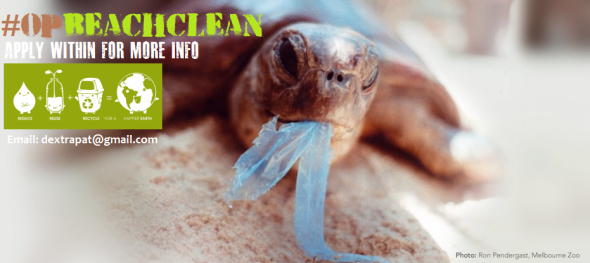
#OPBEACHCLEAN INTERNATIONAL
Saturday 22nd April 2017 I’ve decided to organize the biggest beach clean possible around the globe for Earth Day. The final straw came after I went through all reported aquatic deaths for 2012, 2013, 2014, 2015, 2016 and to date - 2017 only to find that nothing is improving relating to aquatic deaths declining, or waste on our beaches decreasing either. (Pic Credits: Ron Pendergast, Melbourne Zoological Society. Click the image above to be directed to our events site page on Facebook.com.)
The United States of America is now clocking up as the second largest country on the planet that’s reporting trillions upon trillions of mass fish deaths, dolphins, whales, false killer whales, crabs, and numerous aquatic sea birds too. The problem in America is now so concerning, that an immediate investigation has been launched to try and figure out just what is going on in the States of America.
The image below details the worst states hit for 2016. Florida is ranking as the worst with 14 mass aquatic deaths - that’s 14 reports from January to December 31st clocking up billions of fish, hundreds of birds and just under one hundred whales, and mostly dolphins. And if you think this is concerning wait for the next report.
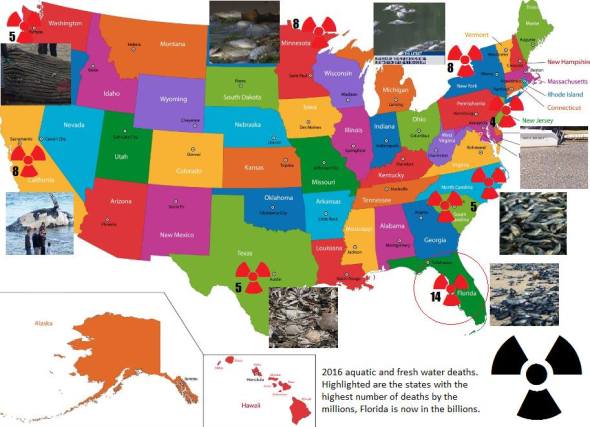
Image: Aquatic Death Mapping 2016. Click The Image For Further Info.
Don’t think for one minute neither that these are the only affected States of America. Every single state that has a shoreline reported deaths from the lowest being (1) mass death in the millions of fish, with the second lowest being (5) and as explained the highest (14.) Florida is the only state out of all fifty that is reporting a massive loss of marine and fresh water aquatic life. Scientists have been quoted as “left baffled by what’s going on in Florida.” I believe I know the answer, however require that final strand of evidence.
OPERATION BEACH CLEAN BY COUNTRY LIST SO FAR
- ENGLAND: (2 BEACH CLEAN OPERATIONS)
- AUSTRALIA: (1 BEACH CLEAN OPERATION)
- VIET NAM: (2 BEACH CLEAN OPERATIONS)
- OMAN: (1 BEACH CLEAN OPERATION)
- HOLLAND: (1 BEACH CLEAN OPERATION)
- THAILAND: (1 BEACH CLEAN OPERATION)
- UNITED STATES: (1 BEACH CLEAN OPERATION)
NB: The list above will be updated, for more information please click here: #OpBeachClean
I myself will be participating in the East Anglia region of Eastern Great Britain. Moreover there are a large number of volunteers that have already come forward to volunteer their time and effort cleaning our shorelines of waste that is unfortunately a contributing factor to many marine deaths globally.
QUESTIONS AND ANSWERS
Q: What time do I start my beach clean?
A: I’ve set my time for 09:00hrs however you can start when you want. Furthermore I’m going to be spending the best part of the day until sunset, however you can finish when you feel you’ve had enough, or if you’ve commitments to keep too and dependents to check on.
Q: What date is the event #OpBeachClean running on?
A: The date for #OpBeachClean is Saturday 22nd April 2017.
Q: Do I need to bring anything?
A: Yes, not too many things but obviously the basics. Checking the weather first before you depart, suitable clothing is a must. You’ll also need hard wearing gloves to keep your hands safe from glass, metals or syringes (etc.) Refuse bags, and if you feel its necessary - which I will highly suggest anyway, high visibility vests just so people know you’re about, working next to cycle paths, roads, or other busy areas too. Normal household weighing scales that you weigh yourself on to estimate the weight of each refuse bag for scientific documentation purposes. A clipboard and paper/notepad to document each piece of plastic, tin can, and clothing you retrieve (etc.) Finally food and beverages.
Q. Why do I need a notepad/clipboard and paper for?
A. I the event organizer require data relating to what you’ve retrieved to document within reports that will be presented to the United Nations, The Hague, and manufacturers too around the world. For example: If you retrieve 3 plastic bags, 5 beer cans, 20 tooth brushes, and 8 milk cartons, please document down the number of bags, cans, milk cartons (etc.) Furthermore if there is any identification on them objects such as (Tesco bag, Carlsberg beer, Unilever tooth brush, ASDA 2 pint milk carton.) Please document the name down next to the number of items like I have below.

Image: Example (1) Beach Clean Check List.

Image: Example (2) Beach Clean Check List.
NB: THE FOLLOWING DATA ABOVE I REQUIRE FOR DOCUMENTATION AND REPORTING TO THE RELEVANT GOVERNMENTAL DEPARTMENTS, AGENCIES, AND MANUFACTURES.
Q: Why do I need weighing scales for?
A: you’ll need weighing scales to weigh each bag, to conclude the final weight of each bag for reporting and research.
Q: Do I need a permit to clean a beach for free?
A: In all of the countries listed above, no you don’t require a permit. However in Thailand you may do.
Q: Will I need to take the waste to a refuse/recycling center?
A: If you can take the waste to a refuse/recycling center that would be great. However I will do everything I can to ensure the council or municipality either provide a skip for you, or inform them of where your waste has been dropped off for them to pick up.
Q: Can I change the date to a Sunday or after a public holiday?
A: In some countries such as Viet Nam public holidays are nearing for May. If you want to change the date for that time period then please do so, however please keep me informed.
Q: Can I take donations for your organisation?
A: Strictly no, I self fund my own organisation and do not rely on public funding. If you are a charity though non-related to myself that wish to take donations on behalf of your own charity/organisation then please remember you will need permission from the council in most cases.
Q: What if I need to cancel the event for reasons out off my control, can I chose another date?
A: Yes of course, I don’t see why not, as long as I’m provided with all the data required above, and we hit these beaches hard then so be it.
Q: What do I do if I locate a munition (Eg: WWI, WWII bomb?)
A: You call the POLICE IMMEDIATELY AND VACATE THE ENTIRE BEACH AS SOON AS POSSIBLE.
Q: What do I do about chemical containers, chemical leaks, spills or syringes?
A: Please leave all chemical containers where they are unless you’re qualified to remove with the relevant certification, if not then please inform your local environmental agency providing the location as soon as possible. In relation to syringes; your local chemist, medical surgery or hospital should provide you a free sharps box to place all syringes in safely. Please DO NOT pick the syringes up with your hands, but with a litter picker if you have one, and dispose safely. Once you’ve finished your beach clean please return the sharps box from where you was given it. If in the event you are pricked by a needle you’ll need to go straight to hospital or your local emergency medical doctor/nurse without delay!
Planet Earths beaches and rivers are becoming more polluted by the year. Aquatic marine deaths are skyrocketing, birds are dying at sea, whales, dolphins and crabs are washing ashore in the thousands and millions. The major problem we’re facing today though is plastic waste, drought, chemical spills, climate change, sonar, oil drilling, mining, dredging, sun exposure to the reef, rising sea temperature levels and even naval military exercises.
Human pollution though in the way of what you see in the video above, especially plastic, is one of the major concerns that threatens not just flora and fauna, but also the health of humans. Plastics gradually break down into micro-plastics of which are then eaten by smaller fish. human consumption of fish makes up a major part of our staple diet, and with plastic seeping dangerous chemicals into fishes bodies - its not just the fish we’re then consuming, but also the dangerous plastic toxins too.
To date Scientists still don’t know what the future holds in relation to these micro plastics, their toxins and how they’re going to affect human health. Marine and Human Scientists did warn though only last month that these chemicals are soon going to come back and haunt us in the way of cancers, diseases, and disorders.
Today, plastics accumulate in garbage dumps and landfills and are sullying the world’s oceans in ever-greater quantity. And plastics and their additives aren’t just around us, they are inside virtually every one of us— present in our blood and urine in measureable amounts, ingested with the food we eat, the water we drink and from other sources. And its all because of us, our obsession with plastic has in a sense turned into a nightmare, an addiction, everything we purchase is virtually plastic and 80% of the plastics we use, we only use once of which is then thrown away. That’s shocking.
“IF WE DON’T TAKE ACTION SOON, PLASTIC WILL OUT-NUMBER EVERY FISH IN THE OCEAN BY 2050”
To take part in #OpBeachClean please email here: dextrapat@gmail.com alternatively please contact me via my personal Facebook page here: Jose Please invite any friends and yourself to the event page on Facebook here: #OpBeachClean I would also like images of your work, a video diary too if possible, and any video/image shocking evidence of waste pollution you locate.
I do require the name of the beach your cleaning, coordinates, number of people, names of the event leaders, charities and organisations that will be taking part too. Once all data is sent into me by my email or via my personal email Facebook box I will submit each story online for Earth Day 2017, and communicate to the press and media too.
Finally all data you retrieve can be photographed and uploaded to me, emailed to me, or sent via post. The results from each beach clean will help me to better understand what’s going on within each stretch of ocean, how best to tackle the current problems, who to talk with relating to companies and their production of plastic materials, and government organisations of which I will be pushing with the evidence obtained from you ladies, gentleman and children for laws to be implemented, guidelines, charges and where necessary bans too.
Beaches that have little in the way of refuse bins, signage relating to no pollution, fine charges, will see me contacting the relevant environmental agencies, and councils to pull their finger out and begin caring more for our beaches and aquatic life. All other results will be presented in numerous graphs to the U.N, and Hague of which I will be without a doubt pushing for answers.
Any questions please email me below. Thank you to everyone that has come forward so far, what you’re all doing on the 22nd April isn’t just cleaning as I am, but your helping to make change happen, pushing for cleaner beaches, and answers from top governmental agencies.
Thank you.
Dr J. C. Depre.
Environmental, Botanical and Human Scientist.
ENDANGERED SPECIES MONDAY | SPOTTED SEAHORSE FACING EXTINCTION.
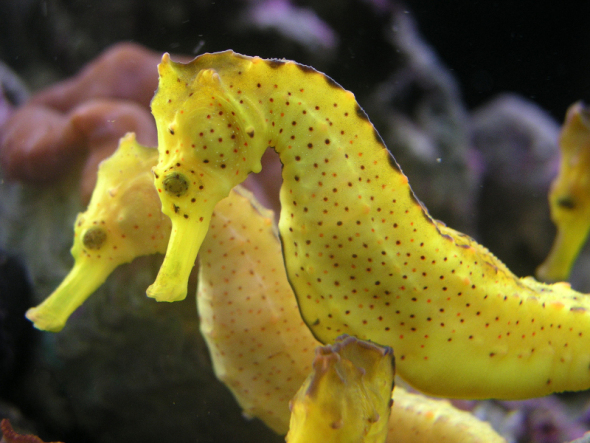
ENDANGERED SPECIES MONDAY | HIPPOCAMPUS KUDA
Once a common site within our oceans, the spotted seahorse (common seahorse) is facing extinction. The largest threat known is use and trade within the Traditional Chinese Medicine culture. As of 2015 its estimated that some twenty million (20 million) seahorses are used within the Traditional Chinese Medicine trade. (Photographer unknown).
Known in Mandarin as Hai Ma seahorses are believed to cure a wide spectrum of ailments and diseases and generally help to improve health. There is no evidence that I can locate to prove seahorses can improve human health in anyway shape or form. T.C.M practitioners have alleged seahorses can cure anything from asthma, arteriosclerosis, incontinence, impotence, insomnia, thyroid disorders, skin ailments, broken bones, heart disease, throat infections, abdominal pain, sores, skin infections.
Broken bones? Now that is about as ridiculous as it gets, impotence and broken bones are not illnesses but more physical complaints of which consuming seahorses is about as effective as pouring boiling hot water onto a third degree burn. A study in Taiwan located some fifty eight (58) sea horses from Taiwanese T.C.M vendors. A total of eight (8) different species were located. Seven (7) were listed as vulnerable, while one (1) was listed as endangered.
Source: http://www.jfda-online.com/article/S1021-9498(13)00043-4/abstract
The species listed as endangered was Hippocampus capensis commonly known as the Knysna seahorse (pictured below). The remaining seven (which doesn’t include the species pictured above) are scientifically identified as Hippocampus algiricus, Hippocampus comes, Hippocampus histrix, Hippocampus kelloggi, Hippocampus kuda, Hippocampus spinosissimus, and Hippocampus trimaculatus. If we include the species above - Hippocampus kuda this makes a total of eight (8) listed as vulnerable, and one (1) listed as endangered equating to nine (9) in total nearing extinction.
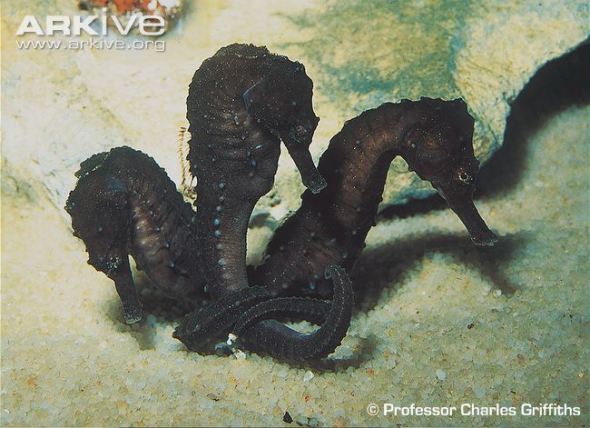
Image: Knysna seahorses | Credits Professor Charles Griffiths
Its quite possible there could be many more species of sea horses that haven’t been listed on the International Union for the Conservation Of Natures Red List [IUCN]. Hippocampus kuda was identified back by Dr Pieter Bleeker (July 10, 1819, Zaandam – January 24, 1878, from The Hague) whom was a Dutch medical doctor, ichthyologist, and herpetologist.
He was famous for the Atlas Ichthyologique des Orientales Neerlandaises, his monumental work on the fishes of East Asia published between 1862 and 1877. I don’t state this often however am going to repeat oneself again. Every single species of animal I’ve written about identified from the (1800’s) has almost all but gone extinct or are at least on their way towards extinction. Another pattern I have found is that many animals and plants used within the (T.C.M) trade were being used thousands of years ago - long before non-Asian travelers identified them. When the species are eventually identified - individual specie populations begin declining!
Since 1996-2003 the common seahorse has been listed as vulnerable, populations are declining very fast, furthermore there was little mentioned about the species at CoP17 in Johannesburg, South Africa; a country that is responsible for a large proportion of seahorse harvests. These harvests are legally shipped from South Africa into Asia, yet large numbers of seahorses are decreasing in South Africa.
I.A.R.F.A Environmental Crime Investigators located one legal trader identified as NGWABE TRADING that hosts a supplying ability of TWO HUNDRED METRIC TONS a month. When we inquired where these seahorses are harvested from, and the species caught we were not given a straightforward answer. NGWABE TRADING was though able to supply us with seahorses that have paperwork (all allegedly legal and above-board.) Yet we’re losing the vast majority of our seahorses. Furthermore I am very suspicious as to whether all of these seahorses are being harvested legally.
Two hundred metric tons per month is no different to two hundred metric tons of sand, cement, or rocks. On questioning the fishing company which I myself do suspect illegal poaching is going on here, many of these seahorses are dry traded to Asia. We’re talking big bucks too. So if this trade was restricted, or even banned, its likely South Africa would lose her seahorses in a matter of years, because legal farming operations wouldn’t be allowed if trade bans came into place. Meaning poaching would increase on a wide scale to supply Asia’s appetite for pseudo medicines.
Source: http://southafrica.tradekey.com/dried-sea-horses.htm
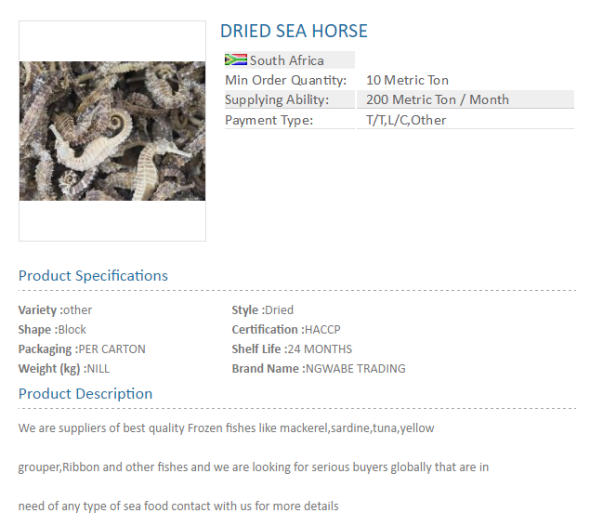
Image: One of many legal online seahorse/fish traders trading to Asia.
Seahorses are also used as an aphrodisiac and to facilitate childbirth in the T.C.M trade. As much as I want to disbelieve this, there is unfortunately “some scientific evidence” that does prove to a degree consuming a regular fish diet can improve sexual behavior within humans; however helping to conceive I am somewhat skeptical about. Sources are cited below for your information from the scientific community.
Source 1: http://www.pbs.org/wgbh/nova/seahorse/vincent.html
Source 2: http://www.acupuncturetoday.com/herbcentral/sea_horse.php
Between twenty (20) and forty (40) million seahorses are allegedly harvested every-year for the T.C.M trade, however if we go on the amount of trade originating from South Africa - its obvious that by the ton load this number is seriously under-quoted. If I myself was purchasing the minimum ton load of ten (10) tons per month - that would easily equate to over twenty (20) and forty (40) million seahorses per annum based on twelve (12) months.
So I think its safe to say we’re looking at possibly hundreds of millions rather than the claimed IUCN stats. I must also note that the spotted seahorse is listed on Appendix II, and to date we will never really know how many seahorses remain within their endemic range, or how many are illegally harvested?
The common seahorse in question which is the species harvested the most for the T.C.M trade is endemic to the following regions: American Samoa (American Samoa); Australia (Northern Territory, Queensland); Bahrain; Cambodia; Fiji; French Polynesia; Hong Kong; India; Indonesia; Japan; Kuwait; Malaysia; Micronesia, Federated States of ; Mozambique; New Caledonia; Pakistan; Papua New Guinea; Philippines; Saudi Arabia; Singapore; Solomon Islands; South Africa (KwaZulu-Natal); Taiwan, Province of China; Tanzania, United Republic of; Thailand; Tonga; United States (Hawaiian Is.); and Viet Nam.
Endemic ocean locations are: Indian Ocean – western; Indian Ocean – eastern; Pacific – western central; Pacific – northwest; Pacific – eastern central.
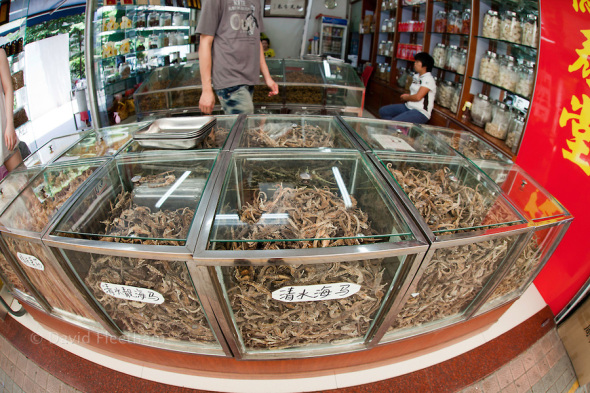
Image: Dried Seahorses for sale, China | Credits David Fleetham
THREATS
Common threats are cited above in more detail. Major threats though are listed below for your immediate attention:
Hippocampus kuda is threatened by damage to its habitats from coastal development and destructive fishing practices. Land-based activities such as coastal construction can diminish seagrass beds and mangroves while leading to increased pollution and siltation in surrounding marine waters. For example, in Malaysia Hippocampus kuda numbers declined due to an extensive port development around the Pulai Estuary that destroyed large tracts of seagrass meadow.
Fishing methods such as trawling result in substantial damage to seagrass beds globally, and especially in the Indo-Pacific. The decline in and fragmentation of the species’ habitats throughout its range indicates possible declines in populations in addition to those caused by fisheries.
All seahorse species have vital parental care, and many species studied to date have high site fidelity, highly structured social behaviour, and relatively sparse distributions. These life history parameters often make species susceptible to exploitation as has been demonstrated for a number of species, including seahorses. Although seahorses also have some traits, such as small body size, fast growth and high fecundity, that may confer resilience to exploitation pressures.
Due to the mode of spawning exhibited by Hippocampus kuda (ovoviviparous brood pouch male parental care), fecundity is comparatively low compared to non-brood pouch spawning fishes and therefore its capacity for population growth is more limited than other species. As a result of the lack of broadcast spawning of pelagic eggs, dispersal of potential recruits is limited. Additionally, given the limited swimming abilities of seahorses, it is highly unlikely that rescue effects would occur from adjacent populations.
Concluding: I am somewhat concerned about the species future survival. CITES is allowing use and trade however those countries that are listed under the convention are allegedly strictly regulated and monitored - I don’t call ten tons per month from one South African company strict regulation. Countries that are importing/exporting must prove they have permits, however I don’t quite understand how this area of monitoring is working - which it clearly isn’t as the seahorse trade is colossal within many Asian countries and South Africa too.
Hippocampus kuda is listed as vulnerable in the National Red Data Books of Singapore and Thailand, and endangered in the Red Data Book of Viet Nam. In France it is illegal to import seahorses under the name H. kuda.
The future is bleak unfortunately and with trade so fanned out, and from what I have seen on my visits to Asia (increasing) I do honestly believe we’re going to be reporting extinctions in the ‘very near future.’ To date there are thirty two (32) identified species of seahorses. Ecologically, they are important in food chains, consuming tiny fish, small shrimp, and plankton, and being consumed by larger fish (such as tuna and rays) and crabs. So if we lose the seahorse we lose yet another vital source of food for endangered tuna species, rays, crabs, and even whales (Etc.)
Source: http://www.newworldencyclopedia.org/entry/Seahorse
Thank you for reading and please share to create awareness and to improve education.
Dr Jose C. Depre.
Environmental, Botanical & Human Scientist.
SHOULD VIET NAM BE SLAPPED WITH TRADE SANCTIONS? | ILLEGAL WILDLIFE TRADE.

SHOULD VIET NAM BE SLAPPED WITH FULL TRADE SANCTIONS?
Since 2012 International Animal Rescue Foundation Africa’s (Cyber and Environmental Crimes Team) have been investigating Viet Nam’s illicit and illegal wildlife trade more closely than we’ve ever done. Back in January 2015 I Dr Jose C. Depre the (CEO) ordered a meeting with both units from the Environmental Cyber Crimes Team and External Affairs Unit); both focusing on the ground and online trade of illegal wildlife contraband. My aim was to increase both online and ground team investigations to begin breaking the back of these ruthless criminals throughout Asia and Africa.
International Animal Rescue Foundation Africa since founded have conducted 1,033 investigative surveys relating to all areas Viet Nam’s illegal wildlife trade (online and ground trade). However it wasn’t until January 2015 after uncovering a colossal rhino horn trafficking ring within Thailand and Viet Nam that we eventually decided Viet Nam had to be investigated more in-depth - all of which has resulted in a number of arrests and confiscation orders this year alone. The ongoing investigation was ordered due to a suspicion that the illicit ivory trade was increasing in Viet Nam too. Furthermore various organisations, media and press had stated that Viet Nam’s wildlife trade was actually decreasing, neither of which was true!.
I.A.R.F.A’s investigations aren’t just focused on Viet Nam. Specialist teams locate traffickers, suppliers and even poachers. These highly trained investigative officers move from one country to the next discretely monitoring and following various traffickers and kingpins (not forgetting befriending others too - which in many cases can be quite dangerous). While most of our investigations have focused primarily on Viet Nam, China, Thailand, Laos, Japan and Malaysia. Investigative officers have also been working within Uganda, Angola, South Africa, Namibia, The Democratic Republic of the Congo, South Sudan, Niger, Nigeria and Burkina Faso (among many other countries).
In four days time South Africa will be hosting the next Conference of Parties (CoP17). The Convention on International Trade in Endangered Species of Wild Flora and Fauna (CITES), that now hosts some 184 CITES signatories which will be debating numerous issues relating to both flora (plants) and (fauna) animals. The meeting will take place from the 24th September to the 5th October (2016). Back in 2011 Interpol estimated the extent of the illegal wildlife trade between $10 billion and $20 billion per year. This figure has gradually increased since 2014.
The illegal wildlife trade isn’t confined to just one country. Many countries around the world host wildlife trafficking and dealing routes extending to every continent. Conservationists say the problem is most acute in Southeast Asia. There, trade linkages to key markets in China, the United States, and the European Union; lax law enforcement; weak border controls; and the perception of high profit and low risk contribute to large-scale commercial wildlife trafficking. The ASEAN Wildlife Enforcement Network (ASEAN-WEN) ASEAN Wildlife Enforcement Network, supported by the U.S. Agency for International Development and external funders, is one response to the region’s illegal wildlife trade networks.
Figures from 2014-2015 have shown a startling increase relating to the funds generated from the illegal wildlife trade. Today illegal wildlife trade is estimated to be worth US$50-150 billion per year. The global illegal fisheries catch is valued at US$10-23.5 billion a year and illegal logging, including processing, at US$30-100 billion. (Source: Illegal Wildlife Trade 2014-2015). So as one can see no matter how many meetings we’ve been holding the illegal wildlife trade is skyrocketing to levels that we’ve never seen before. The question is though, how do we as environmentalists stop this, how can we force violating countries to take notice?
International Animal Rescue Foundation Africa have been calling on CITES for more than five years now to impose trade sanctions against offending countries. Unfortunately CITES and their signatories haven’t in our opinion taken a blind bit of notice, especially when it comes to Viet Nam that has been blacklisted as ‘possibly the largest threat to global wildlife on the planet?’. A trade sanction (which is what we want placed against Viet Nam and other offending countries) is a trade penalty imposed by one nation onto one or more other nations. Sanctions can be unilateral, imposed by only one country on one other country, or multilateral, imposed by one or more countries on a number of different countries. Often allies will impose multilateral sanctions on their foes.
From 2015 we (the organisation) have located a staggering $13.5 million (USD) of illegal wildlife contraband - most of which is being traded online via various forums such as Facebook within secret groups. (You can view a some of the contraband we investigative via our Facebook page here). On speaking to numerous traders to try and understand why this trade was being conducted on line; the traders have always stated: (Its more safer to trade, they can trade to a wider market without the need to carry their products over many miles. Finally, its quicker to trade into large private buy and sell forums anything that would be deemed ‘hot to handle’ such as Rhinoceros horn, elephant ivory, and pangolin parts (Etc).

Image: Mr Tuan advertises the authenticity of recently smuggled rhino horn 11th August.
I.A.R.F.A have located over 21 African Rhinoceros horns traded illegally online and via ground markets since 2015 when we began our new anti wildlife trade operations and, 9 Indian One Horned Rhinoceros horns (all authentic). Mr Tuan, a Vietnamese national had no qualms whatsoever proving the legitimacy of his recently smuggled horn from South Africa. Anti Wildlife Trade Officers were invited to Mr Tuan’s Hanoi antiques shop of which in the back room were four recently poached Rhinoceros horns. I.A.R.F.A Anti Wildlife Trade Officers posing as interested buyers were offered the above in liquid form as a ‘so called aphrodisiac’.
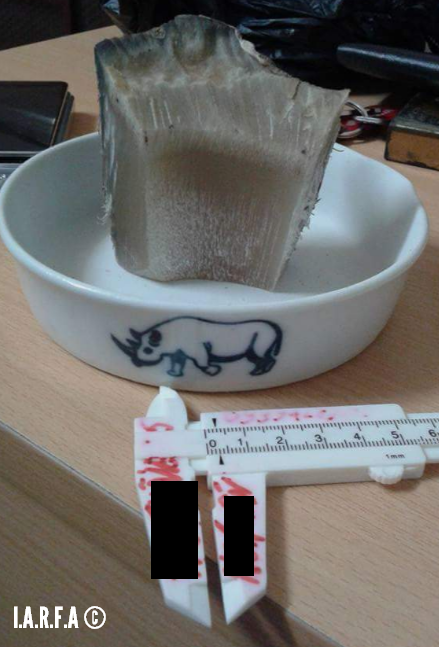
Image: Mr Tuan prepares to sell this horn to I.A.R.F.A investigators.
The above horn was measured up, weighed and offered to I.A.R.F.A investigative officers for a total of $4,000(USD). While the officers declined a small sample was purchased so that we could test the authenticity of this horn. Vietnamese investigative officers working with (I.A.R.F.A) the very next day took the sample to Viet Nam National University of which tests later revealed the horn originated from an African Rhinoceros based on the horns DNA.

Image: One of Viet Nam’s many Rhino horn kingpins. Mr Tuan.
While we don’t make a habit of exposing ‘wealthy wildlife trade kingpins’. As we’re nearing the (CoP17 summit) we believe its time to begin naming and shaming some of the dons behind this ruthless trade in order to communicate our message far and wide to all CITES members that enough is enough, sanctions must be placed against all violating countries. Mr Tuan doesn’t just deal in large quantities of authentic Rhinoceros horn neither. Ivory, pangolin parts and the critically endangered Indochinese Box Turtle also fill Mr Tuan’s home and antiques shop. So Mr Tuan if you’re reading please do say cheese.
Meanwhile Mr Tuan is just a small piece of the ever-increasing illegal wildlife trade iceberg. In one group that we’ve been monitoring for over two years that’s yielded 9 arrests thus far this year (which we cannot name for legal reasons). Some 33,000 individuals all over the globe are trading ivory, tiger parts, bear claws, pangolin scales and critically endangered moon bear skins (among many other items). The vast majority of these online traders that lead investigative officers to some ground locations are either Vietnamese, Chinese, Malaysian, Indonesian, Indian, Belgium, Australian, American and Canadian traders. One trader was even located in London W12, and two others dealing from Paris, France.
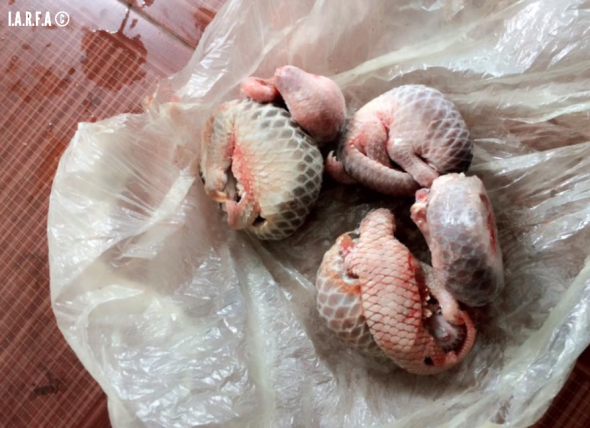
Image: Thailand smuggled endangered pangolins.
Rhinoceros horn is the least likely wildlife trade product that we come-by, simply because of its price, rarity, and the fact so many people around the globe are now putting their foot down relating to this animal part. Unfortunately its not just Rhinoceros horn that we witness being sold illegally online and on the ground. Mr Tu Su whom lives in Ha Tan, Viet Nam was clocked on the 19th August 2016 trading these smuggled pangolin parts online illegally.
Every year there are numerous arrests throughout Asia and convictions relation to pangolin poaching and trafficking, however no sooner is one dealt with - another smuggler and trader rears their ugly head, and can you blame them? All four Asiatic pangolins are now considered extremely rare to the point they’re nearing extinction. Furthermore as the species becomes more rarer - prices increase. These 6 pangolins were trading between $600(USD) and $1000(USD) each. Mr Tu Su has has quite a reputation relating to pangolin smuggling - so for the record below is Mr Tu Su’s face.

Image: Mr Tu Su - Pangolin smuggler and trader.

Image: Mr Tu Su - Pangolin soup.
All 8 species of Asian and African pangolins are ‘listed under Appendix II of CITES’, which means trade is regulated and monitored under CITES, (permits are required from exporting countries for any trade activity). To issue a permit, the exporting country must determine that this activity will have no detriment to the wild population.
As an additional protective measure, the CITES authority passed a (zero export quota for the four Asian species, which bans all commercial trade in these species). However, other purposes (scientific, research, etc.) can still be authorized by permit. For the four African species, there is no zero export quota, which means commercial trade is not prohibited, but permits are still required. Pangolins are also protected in their range states by domestic wildlife laws.
So Mr Tu Su if you’re reading then please note you’ve violated both domestic and international law, we’re holding your details too!
International Animal Rescue Foundation Africa have increased investigations relating to the illicit wildlife trade. Our two main areas of focus is that of the Rhinoceros horn trade and the ivory trade. Since 2015 our investigations surrounding the illegal ivory trade (have located a staggering $6 million(USD) of ivory smuggled from Africa into Thailand, China, Malaysia, Singapore and, Viet Nam.

Image: Ivory trafficked from Tanzania onto Viet Nam.
Ivory trader and trafficker Mr Ban Me from Buôn Ma Thuột, Đắc Lắk, Vietnam was observed on the 16th August 2016 trading the ivory above online in one of three secret Vietnamese and Chinese ivory trading online forums. The ivory above is estimated to be around $6,500-$8,000(USD) for the lot.
Mr Ban Me makes no effort to conceal his lucrative online trade neither. When investigating this trader and trafficker we went back through many months of posts within the secret forum, then managed to locate Mr Ban Me who is aged around 35-30 years old. On locating the trafficker/trader it appears from the online evidence that ivory is coming in quick, measured up and weighed, of which either himself or friends then soon after set about to carve the ivory into jewelry.

Image: Ivory measured up and weighed for sale and carving.
Since January 2015 (International Animal Rescue Foundations) Environmental Crimes Officers have underneathed new trading trends relating to the ‘online wildlife trade’. As explained in previous articles most traders nowadays will take delivery of illegal wildlife contraband. From there the wildlife parts are then photographed (as seen in the image below). Traders will either then set up a ‘pseudo Facebook profile’ or already have one in place. The Facebook profile will act as a mobile online shop.
Most traders and traffickers we’re investigating today use this method of online illegal trading. They know by using a throw away or cheap (non-traceable cell phone) that any chance of them being located is slim. Traders are rarely seen selling in bulk on the streets of Viet Nam or over the borders in other Asian countries. Buyers and traders feel safer trading, swapping or trafficking items uploaded to the internet.
Mr Ban Me takes delivery of a large quantity of ivory every month from Africa, most of which has been illegally trafficked into China. Once carved the items are then photographed again to sell online within secret trading rooms to hundreds if not thousands of people. The ivory seen above and below was ‘advertised’ to an audience of over 33,000 individuals.
So as you can see its incredibly difficult for us or any investigate organisation to track in quick time where these products are originating from and ending up. Traders use these rooms online because they know selling to a wider-ranged audience products can shift quickly. Unfortunately for Mr Ban Me we have his contact details, his address, his cell phone numbers, and even know who is selling too and buying from.

Image: Carved ivory on sale from the tusks observed and intercepted online.
Another shocking ‘concern’ is that Mr Ban Me ‘could be purchasing ivory from Thailand elephant traders’. I.A.R.F.A have known for many years now that ivory tusks are being shaved down from Asiatic elephants. A trace of Mr Ban Me’s cell phone images revealed further evidence that showed himself photographing Asian elephants onto his ‘Facebook ivory profile’. Should this be true - it will prove to be further damning evidence that elephants are being exploited within Asia for the ivory trade on a much larger scale than previously documented.

Image: Ban Me photographs Asian elephants onto ivory Facebook profile.
The only image we have of Mr Ban Me is that of his wood workshop in Viet Nam (pictured below). The entire Facebook profile (like many thousands more we have and continue to observe) depicts that of ivory and few rose wood products. The question is though - who’s supplying this young Asian man with ivory? I.A.R.F.A have demanded that Facebook and the F.B.I take action against this illicit trade, and even supplied the Social Media platform with an 11,000+ petition signature however as yet nothing is being done to combat this trade?

Image: Mr Ban Me carving wood in Viet Nam. where ivory is also traded.
Back in December 2015 International Animal Rescue Foundations (Environmental Crime Officers) passed hundreds of pages of evidence onto international law enforcement agencies and Interpol relating to illegal wildlife traders. There have been numerous arrests due to our investigation and, from that investigation other individuals have been looked into resulting in new investigations and arrests too on a global scale. However no sooner is one trader stopped - another one pops their ugly head up from the sand and begins trading.

Image: Mr Ban Me’s ivory Facebook shop profile - ivory tusks, and carved ivory jewelry.
A further trader that ‘openly admitted to I.A.R.F.A Environmental Crimes Officers tried to sell these tusks (pictured below) to an I.A.R.F.A investigator. Going under the name of Mr Thường, from Hanoi Viet Nam, he like Mr Ban Me made no effort whatsoever to conceal his hoard of illicit ivory - most of which was from African elephants. Furthermore he too like Ban Me had created a ‘pseudo Facebook profile to trade illegally elephant ivory’.

Image: One of many thousands of online Facebook ivory trading profiles.
Viet Nam banned the ‘domestic ivory trade back in 1990’. Furthermore there has been an ‘international ivory trade ban in place since 1989. Unfortunately while these bans have been in place - there are loopholes within some ‘countries domestic trades’ which permits them to trade ‘legally elephant ivory despite international and domestic bans’.
Furthermore ivory can to some extent be sold legally within Viet Nam should the products be antique or purchased before the ivory trade bans. However neither of our investigative officers have located any evidence to prove any of the ivory we’ve located was purchased/obtained legally before any bans were implemented. Damning evidence sent to law enforcement agencies around the globe also proves that ivory is being smuggled from Africa onto Japan and China then back into Viet Nam - Three countries known for their continued ivory trade violations.
While the ivory trade continues to rage out of control there are unfortunately many other illicit and illegal wildlife trades that are increasing within Viet Nam. I.A.R.F.A have noticed a very ‘alarming spike’ of bear parts, mostly moon bears for sale online and on the ground. Environmental Wildlife Crime investigative officers located this species [pictured below] - Ursus thibetanus on the 8th September 2016. The species is identified as the Ursus thibetanus and is listed as [vulnerable] on the (IUCN RED LIST) of threatened and near endangered species.
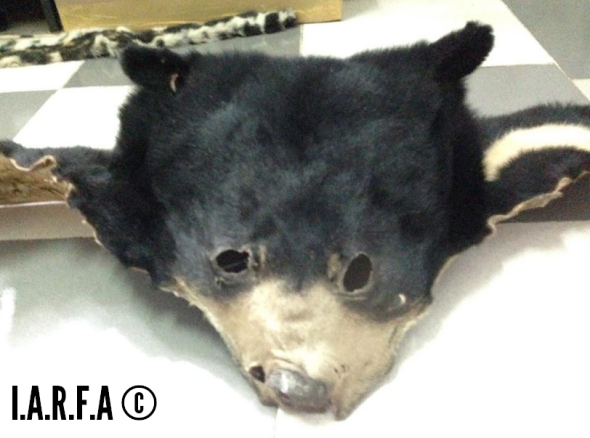
Image: Ursus thibetanus (Moon Bear parts) Viet Nam (2026).
Moon bear pelts, teeth, claws and bear bile are not exactly an uncommon species of animal to be located wihtin Viet Nam’s numerous medicinal markets, although its not common to view the species as it is above on sale within open markets. Bear bile has not decreased in sale on the TCM markets whatsoever in my humble opinion, in fact we (the organisation) hold very recent and damning evidence to prove that bear bile farming practices are sill very much operational. So damning that it does in fact bring many Non Profit Organisations into question with regards to their allegations of practically stopping this trade, when clearly its not being stopped!
Due to many counterfeit animal products on the markets, before any investigation is undertaken - Environmental Scientists will conduct routine examinations of purchased bear bile products to check their authenticity. These examinations are undertaken to store and maintain evidence files, to secure closures of illegal markets or, for further secondary investigations. I.A.R.F.A Wildlife Trade investigative officers located the following bear bile products on the market in Viet Nam.
A kilogram of farmed bear bile might cost $240, while the same amount from a wild bear could cost $15,730. Investigative officers were told the bile seen hereto in the image below was from wild bears, however we highly doubt it due to the lack of Asiatic black bears in the wild. Each bottle below was offered to investigative officers for just over $200(USD). I.A.R.F.A Wildlife Trade investigate officers did purchase three at a price of $600(USD) which is considered cheap. The ‘liquid was tested at the Nong Lam University of which proved to be 100% bear bile.
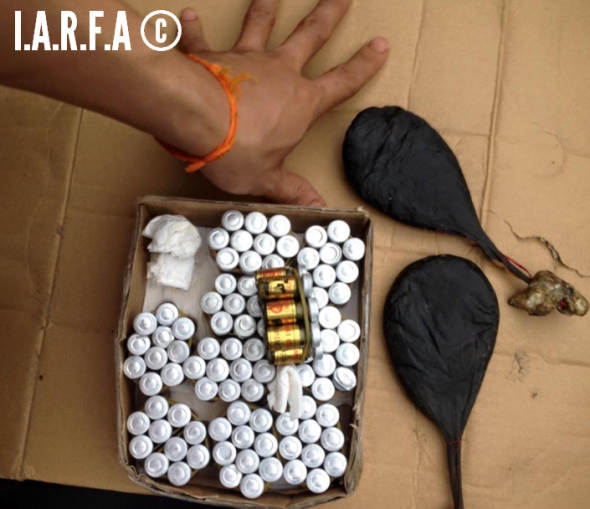
Image: Asiatic Moon bear bile in mass production with gall bladders.
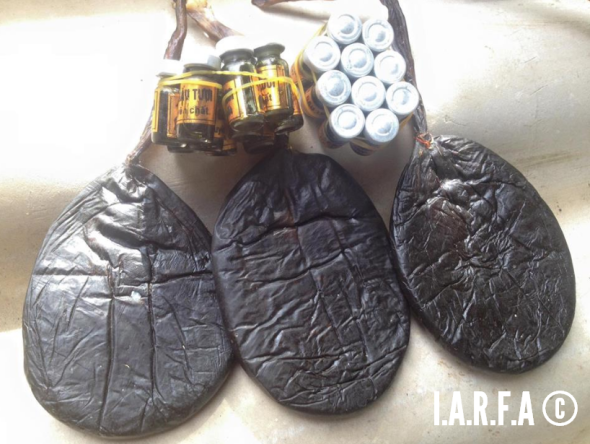
Image: Plastic wrapped gall bladders and bile.
Bear bile does not whatsoever hold any medicinal properties whatsoever, if anything consuming bear bile can actually increase health complaints. The barbaric practice is ‘illegal in China and Viet Nam’, Viet Nam banned bile production back in 1992, sadly the trade still goes on to some extent. Fortunately Viet Nam have stated they’ll be eliminating this horror come 2020, however we’re not holding our breaths just yet.
Mr Nheo who is aged around 21 years of age from the Huong District, living in Hanoi Viet Nam (pictured below) if you’re reading my friend you may want to stop trading pangolins, tiger parts, bear bile, tiger teeth, bear teeth and claws and ivory today. Bear bile hosts no medicinal properties whatsoever so why you’re trading this vile product - which leads to the destruction of bears for we don’t know..

Image: Mr Nheo - Illegal wildlife trader from Hunong District, Viet Nam.
At the last Conference of Parties Summit (CoP15 - Thailand), Viet Nam made a promise to crack down on the countries illegal wildlife trade back in 2013. Although there was no actual deal made, Cites signatories did categorically state that should Viet Nam want any say in the ‘legalized international trade of rhino horn’ the country must clamp down on illegal wildlife trades and markets. I was at the last CoP summit of which Viet Nam agreed it was time to reduce their illegal trade markets - or face the consequences.
The whole purpose of this article and many others is to ‘highlight Viet Nam’s lies; the country hasn’t in my opinion made any progress to reduce their illegal wildlife markets, especially that of (critically endangered species). Yet Viet Nam has been identified as one of the leading countries to be approaching Cites for the ban to be lifted relating to the (international rhino horn trade). I ask myself daily - how is it possible for a country to control any legal trade if they cannot control the illegal trade of wildlife contraband?.
I.A.R.F.A. Environmental Crimes officers working online and on the ground furthermore have noticed a colossal spike in the number of tiger parts and dead tiger carcasses sold within Viet Nam’s illegal wildlife trade markets. The image below depicts a trader that is privately trading tiger teeth. While the quantity of tiger teeth wihtin the image (below) may seem small. I.A.R.F.A Environmental Cyber Crimes officers have been carefully monitoring this trader for well over a year. The vast amount of tiger parts he’s trading is out of this world.
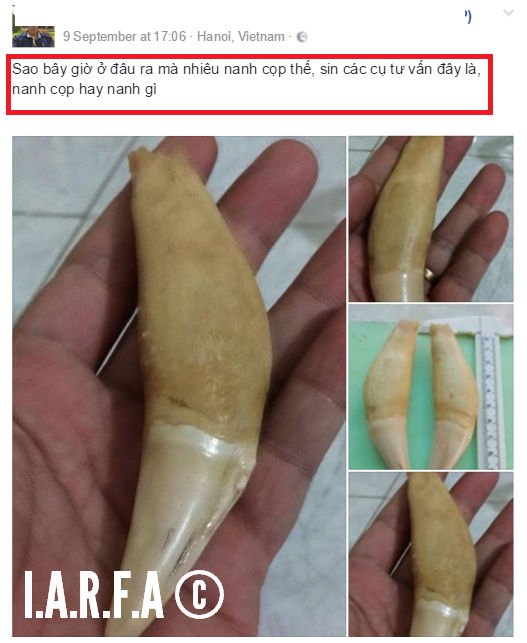
Image: Tiger teeth for sale- Online Secret Wildlife Trading Forum.
I.A.R.F.A have reported various tiger traders in Viet Nam to INTERPOL and local enforcement agencies. However as explained these bloody sickening traders, traffickers and animal killers continue to pop up time again. Most if not all the tigers that we are locating for trade (illegally) were ether captive tigers, smuggled tigers/parts from China and/or Thailand. While other specimens have actually originated from (pathology/veterinary universities inside of Viet Nam).
Three months ago I.A.R.F.A working with overseas enforcement experts concluded - the rare Asiatic leopard we located within a wildlife traders apartment had originated from a veterinary university in Viet Nam. Meanwhile the tiger skins/parts below have originated from Thailand. The question is though from where, who is supplying this amount of tigers and parts to traders within Viet Nam?
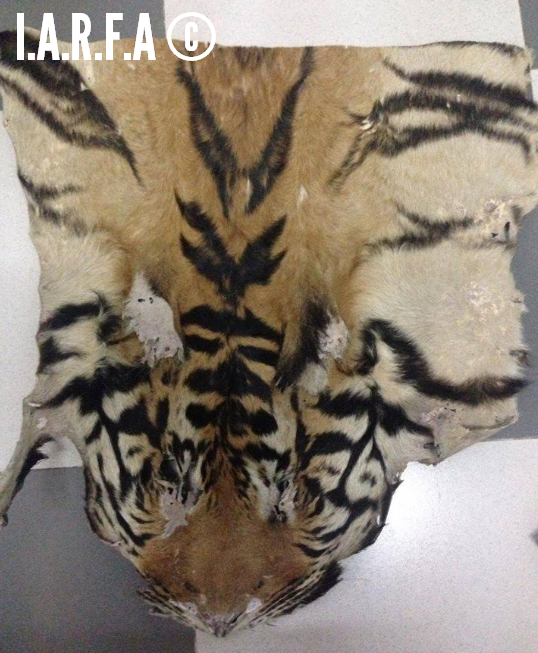
Image: One of many tiger skins offered to I.A.R.F.A investigators September 8th.
International Animal Rescue Foundation Environmental Cyber Crimes Officers was offered this tiger pelt for $1,060(USD). The trader that operates under the name of ‘Mr Coivodich’ also deals in ivory, threatened Rhinoceros hornbills, and bear bile. Furthermore we have been monitoring a very ‘concerning trend relating to tiger skin wallets. Captive bred tigers are slaughtered of which their skins are turned into wallets - a craze that is now becoming incredibly popular throughout Viet Nam. Tigers in Viet Nam are supposed to be bred for conservation purposes only. Clearly though from the images below this is not the case.

Image: Real tiger skin wallets packaged and ready for sale in Hanoi.

Image: Unpacked real tiger skin wallet, priced at $70.00(USD) each.
As explained tigers are supposed to be used for conservation purposes only. However we have located worrying evidence that makes Tiger Temple look more like a walk in the park. A famous Thailand Actor below is seen cuddling a drugged tiger at the Sriracha Tiger Zoo which we believed was a zoo inside of Viet Nam. (See image below). Unfortunately the tiger and this image eventually led back to Thailand, of which this zoo has been named as a horror ground. Would it be wise to assume that tigers are originating from this zoo and ending up within Viet Nam’s wildlife trade? We don’t know. What we do know for sure though is this zoo is now under close scrutiny.

Image: Chen Yunan coaxes drugged tiger in Thailand.

Image: Ranya Rao coaxing drugged tiger in Thailand.
International Animal Rescue Foundation’s Environmental Crimes teams have been working on our new anti wildlife trade project since 2015 being now the ninth major project that we have conducted in the past three years. Most of the evidence we are locating in relation to wildlife trade violations isn’t always within China - a lot of these violations are in fact within Viet Nam.
We are now under four days away from the next Conference of Parties (CoP17) to be held within South Africa, Johannesburg. CoP 17 has been set to be the largest summit held, and as such we may see countries such as Viet Nam asking Cites signatories to agree to a lift of the international trade ban in Rhinoceros horn. Every article that we’ve published in relation to Viet Nam shows the country cannot be trusted with relation to the international rhino horn trade. Every article we’ve published also shows numerous violations of local and international wildlife trade laws.
So the question remains. Is it now time to implement at CoP17 full part of full sanctions against Viet Nam to protect our local and international wildlife? I believe its now time. The evidence in front of you clearly shows Viet Nam’s refusal to act on their illegal wildlife trade markets. So how much more do we have to put up with before everything is eventually gone? Should Cites signatories lift the rhino horn trade ban we’ll keep to our promise. Being all those we know dealing in illegal wildlife products at high end market level will be named, shamed addresses published and that evidence released to the public. Video recordings, audio, images - everything.
The balls now in Cites court - Don’t underestimate us, we may be quiet - but we’ll stay quiet for only a short time before we begin naming and shaming.
Dr Jose C. Depre. PhD. MEnvSc. BSc(Hons) Botany, PhD(NeuroSci) D.V.M.
Environmental, Botanical & Human Scientist.
VEGAN PAZARTESI | PATATESLI PUF POGACA | TURKISH VEGAN.

PATATESLI PUF POGACA | TURKISH VEGAN
Your weekly vegan delightful recipe is out, and may I please suggest that you try patatesli puf pogaca which is a stunningly tasty Turkish breakfast roll. When I was last in Armenia I tried this dish fresh from the bakers, and its the most amazing, tasty, filling and aromatic breakfast roll I’ve ever tried. Vegetarians can opt for the potato and cheese variety which normally consists of feta. However as it is, is just divine.
Every Monday and Friday we publish a vegan or vegetarian recipe onto our main news site, as well as publishing everyday onto our Facebook page various recipes for both vegans and veggies. Please note that we do not any longer use the #GoVegan hashtag. Instead the #TryVegan hashtag, simply because Mondays and Fridays are two days of the week that we encourage ‘thousands of our readers around the world to try a vegan non-meat non-dairy recipe’. There’s no harm in that is there? I didn’t think there was!
Patatesli puf pogaca is a traditional Turkish breakfast roll for those on the go or running a busy lifestyle. Furthermore patatesli puf pogaca can be implemented into dinners and snacks, and you can spice it up a tad too if you’re feeling in the mood. A little ginger or all spice at Christmas is also great - only a little though added to the potato. Okay so here’s the recipe and please enjoy, have a nice day, and enjoy the beginning of your week.
INGREDIENTS:
2 cups luke warm water
4-5 cups flour
1 Tbsp instant yeast (1 package)
2-3 Tbsp olive oil
1 Tbsp sugar
1 Tbsp salt to taste
Potato Filling:
2 large or 3 medium potatoes, boiled and smashed
1 onion, chopped
1 tbsp tomato paste
2 tbsp oil (canola/ sunflower/vegetable/corn/olive)
½ tsp salt
¼ tsp cayenne pepper (optional)
¼ tsp black pepper
¼ tsp cumin (optional)
(NB: If you are allergic to gluten then please opt for the gluten variety ingredients for your fresh bread).
RECIPE:
In a pot boil the potatoes and smash them. Meanwhile in a pan place the oil and onion, and sauté for 2-3 minutes on low-medium heat. Then add the tomato paste, salt and smashed potatoes. Cook for 5-6 minutes stirring occasionally. Finally sprinkle with pepper, cumin and cayenne pepper.
Glaze:
Glaze:
VEGAN: (AGAR AGAR) (There are other substitutes for egg yolk please click here for more information)
1 tsp water
Sesame seeds for top
(NB: If you’re not a vegan you can use one egg yolk, 1 tablespoon of water and sesame seeds on top)
Place the lukewarm water, sugar and the yeast into a bowl. Stir well to dissolve the sugar and the yeast. Add salt, olive oil and flour; knead for 10 minutes, until dough becomes elastic. The more you knead the better your dough will be. Cover the dough with a plastic wrap or a clean cloth, and let it rest for 2 hours in a warm place, till it rises up to double its volume.
Place dough on the counter and punch to release the air. Cut the dough into 20-22 pieces. Flatten each of the pieces with your hands and place 1 Tbsp or more potato filling in the middle and close it up sticking well the ends. Grease a baking dish and place the puff pogacas over, stuck ends being down, leaving some room between each. Cover it with a clean cloth and leave it for ½-1 hours to rise in a warm place (If you have time let it rest for 2 hours).
Mix the AGAR AGAR or if veggie beaten egg yolk and water in a small bowl, then brush the surface of the puff pogacas with this glaze. Finally, sprinkle sesame seeds on top.
Preheat the oven to 400F (200C). Bake for 30-40 minutes, until it becomes golden brown. Take it out of the oven and cover with a clean cloth or towel to keep them soft and warm.
(NB: Do not use metal container when kneading or resting the dough. Metal spoils the texture of dough).
These savory bread rolls are very easy to make, may I suggest if cooking for breakfast that you prepare the dough before bed and leave the dough within an ambient room. Shelf life NO MORE THAN 4+ HOURS due to the potato. You can reheat however they are best served fresh. Yes breakfast can be time consuming however why not make them on a Sunday, or for a snack, you can prepare this wonderful Turkish delight anytime you want too. I’ve included the option for both vegan and veggie as I believe its fair.
(NB: As with all recipes I or others from our main cooking page print - if you suffer from cardiovascular disease, have a history of stroke or are taking sodium based medications then please opt for the low sodium salt. There are alternatives for salt although I myself have never tried them and I’m not sure if these will work in the prepping process of this bread. However you can read more here
Below are two videos. 1. The vegan method, however I still advise to try the above recipe as its no different really to the vegan (Turkish recipe). 2. The Turkish recipe. (PLEASE NOTE VIDEO [2] IS NOT VEGAN). Video [2] is the Turkish traditional recipe though with cheese and potato.
That’s it folks and have a nice day.
Dr Jose C. Depre.
Environmental, Botanical and Human Scientist.
ENDANGERED SPECIES MONDAY | PHOCARCTOS HOOKERI EXTINCTION LOOMING - NATIONAL EMERGENCY.
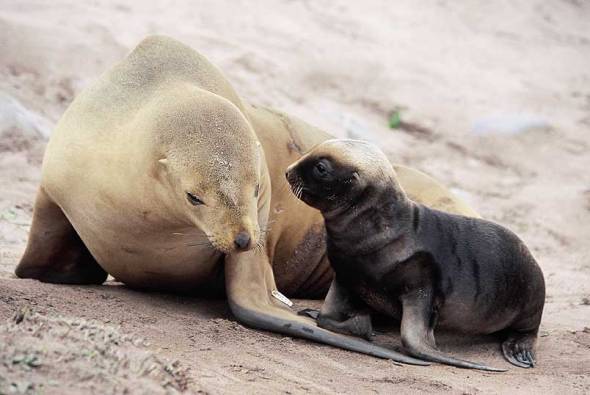
ENDANGERED SPECIES MONDAY | PHOCARCTOS HOOKERI
This Monday’s endangered species (E.S.P.) article I’ve chosen to document on the New Zealand sea lion. Image: New Zealand Sea Lion. Credits: Tui De Roy.
Listed as (endangered) the species was identified by Dr Gray back in 1866. Dr Gray John Edward Gray, FRS (12 February 1800 – 7 March 1875) was a British zoologist. He was the elder brother of zoologist Dr George Robert Gray and son of the pharmacologist and botanist Dr Samuel Frederick Gray (1766–1828).
Dr Gray was Keeper of Zoology at the British Museum in London from 1840 until Christmas 1874, before the Natural History holdings were split off to the Natural History Museum published several catalogues of the museum collections that included comprehensive discussions of animal groups as well as descriptions of new species. He improved the zoological collections to make them amongst the best in the world.
Scientifically identified as the Phocarctos hookeri the species was listed as vulnerable from 1994-2008. Unfortunately due to continued population declines the New Zealand seal is now bordering complete extinction within the wild (and things really aren’t looking good neither) Endemic to Australia (Macquarie Is.); and New Zealand (South Is.), the species is also native to the Pacific North West.
To date there is estimated to be no fewer than 3,031 mature individuals remaining within the wild. New Zealand sea lions are one of the largest New Zealand animals. Like all otariids, they have marked sexual dimorphism; adult males are 240–350 cm long and weigh 320–450 kg and adult females are 180–200 cm long aMnd weigh 90–165 kg. At birth, pups are 70–100 cm long and weigh 7–8 kg; the natal pelage is a thick coat of dark brown hair that becomes dark gray with cream markings on the top of the head, nose, tail and at the base of the flippers.
Adult females’ coats vary from buff to creamy grey with darker pigmentation around the muzzle and the flippers. Adult males are blackish-brown with a well-developed black mane of coarse hair reaching the shoulders. New Zealand sea lions are strongly philopatric.
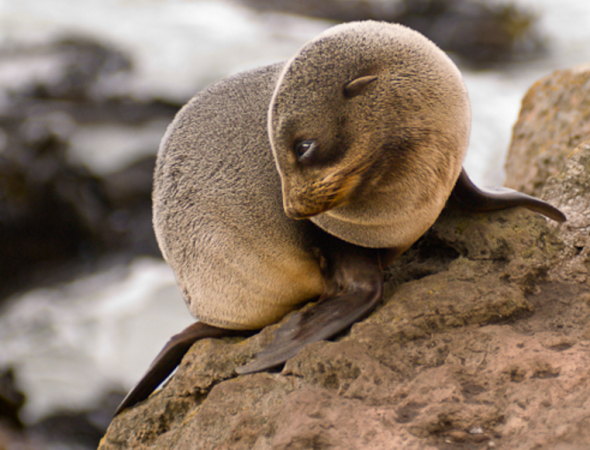
Image: New Zealand Sea Lion Pup. Credits: NZ Fur Seals.
Back in 2012 populations of New Zealand sea lions “were estimated to be standing at a population count of 12,000 mature individuals”. However since that count took place, from (2014) populations have ‘allegedly plummeted’ to all new levels although there doesn’t appear to be any evidence as to why the species suddenly declined - fish trawling and disease have been noted though!.
Like the Maui’s dolphin, the sea lion has come under intense scrutiny this year after research showed its numbers had halved since 1998. It has been classed as nationally critical and if its decline is not stemmed will be extinct within 23 years. A bacterial infection severely reduced breeding in 1997-98, and the species has failed to recover.
Its decline has been compounded by deaths due to squid fisheries, which trawl at a similar depth to the sea lions’ hunting grounds. Conservation groups call the population decline “a national emergency and are calling on stricter by-catch limits and a change in fishing methods”.
BACK IN 2012 THE NEW ZEALAND HERALD REPORTED THE FOLLOWING
In a country with 2800 threatened species, conservation in New Zealand is often about picking winners. The Department of Conservation’s budget and energy can extend only to active interventions for 200 of these endangered species.
Whether a species is protected depends on funding, community input, national identity and research. DoC spokesman Rory Newsam says interventions are often made because the department believes it can “get the most bang for its buck”. But animals and plants are not always invested in because they have a greater chance of survival.
The kakapo receives a relatively large chunk of funding despite being functionally extinct on the mainland. Some ecologists argue too much is spent rescuing the rare parrot, while more crucial parts of our ecosystem are left behind. But the kakapo is protected because it is a charismatic species and the public considers it integral to New Zealand’s ecological identity.
Conservationists say kakapo are a window to New Zealand’s history. They are believed to have inhabited the Earth for millions of years. To kill them off in a fraction of that time is an indictment on the way we live.

Image: New Zealand Sea Lion. Image Credits One Newz.
New Zealand sea lions are known to predate on a wide range of prey species including fish (e.g. hoki and red cod), cephalopods (e.g. New Zealand arrow squid and yellow octopus), crustaceans, seabirds and other marine mammals. Studies indicate a strong location effect on diet, with almost no overlap in prey species comparing sea lions at Otago Peninsula and Campbell Island, at the north and south extents of the species’ breeding range. New Zealand sea lions are in turn predated on by great white sharks, with 27% showing evidence of scarring from near-miss shark attacks in an opportunistic study of adult NZ sea lions at Sandy Bay, Enderby Island.
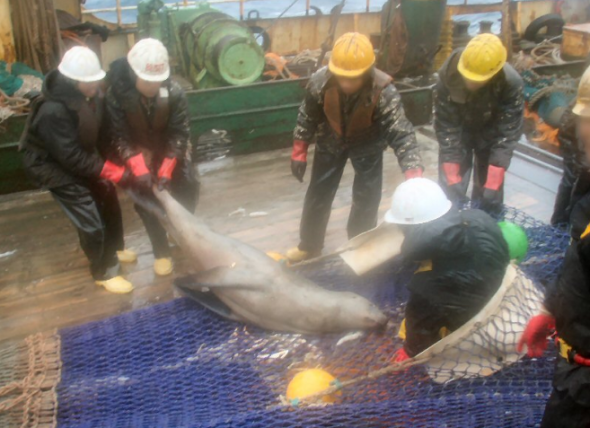
Image: Dead New Zealand Sea Lion in Fishing Net.
Since 2012 New Zealand conservationists, and the public community have been calling on the New Zealand government to do everything they possibly can to preserve this species. Unfortunately as you can see above fishermen are still accidentally killing the species off. As the species is protected under law and listed as endangered, the New Zealand government must take action against these perpetrators, otherwise extinction will most certainly occur.
The Maori people of New Zealand have traditionally hunted Sea Lions, presumably since first contact, as did Europeans upon their arrival much later. Commercial sealing in the early 19th century decimated the population in the Auckland Islands, but despite the depletion sealing continued until the mid-20th century when it was halted.
Commercial sealing in the early 19th century decimated the New Zealand Sea Lion population in the Auckland Islands, but despite the depletion sealing continued until the mid-20th century. The population has yet to fully recover from the period of over exploitation. At the present time, New Zealand Sea Lions have a highly restricted distribution, a small population, and nearly all of the breeding activity is concentrated in two subantarctic island groups. This restricted and small breeding population in combination makes them vulnerable to disease outbreaks, environmental change, and human activities.
The commercial Arrow Squid trawl fishery near the Auckland Islands reported their first New Zealand Sea Lion bycatch mortalities in 1978. Reported or estimated mortality between 1995 and 2007 averaged 92 animals annually (range 17-143) which was 3.7% of the estimated number of mature individuals in the Auckland Island area. Of particular concern is that most bycatch animals are females (up to 91%). New Zealand Sea Lions are also incidentally caught in other trawl fisheries around the Auckland and Campbell Islands.
Apart from direct mortality, competition and habitat modification caused by fishing activity may also be impacting New Zealand Sea Lion foraging areas. Epizootic outbreaks at the Auckland Islands in 1998, 2002, and 2003 led to more than 50%, 33%, and 21% early pup mortality respectively, and were also responsible for the deaths of some animals from other age classes during 1998.
The source of the suspected bacterial agent and cause of the outbreak and subsequent mortality for the 1998 outbreak are unknown, however the 2002 and 2003 outbreaks have been identified as being caused by Klebsiella pneumoniae.
The future of the New Zealand sea lion doesn’t look good at all. I highly suspect that we’re going to lose the species within 10-20 years (if that). More needs to be done to preserve the species habitat and its current fishing grounds as well as protecting from bacterial outbreaks. Failing this the species will be extinct within 10-20 years max. I am highly doubtful here, which is very rare for me to speak about.
Thank you for reading.
Dr Jose C. Depre. PhD. MEnvSc. BSc(Hons) Botany, PhD(NeuroSci) D.V.M.
Environmental, Botanical & Human Scientist.
CAULIFLOWER & OYSTER MUSHROOM TACOS | VEGAN FRIDAY - #TRY VEGAN.

SPANISH CAULIFLOWER & OYSTER MUSHROOM TACOS
Your #TryVegan Friday recipe is now out. We’ve opted for something different to show our readers this week. I made this dish late July, not being a great fan of tacos however a massive fan of mushrooms. Added to the taco and with the cauliflower this dish is outstanding, furthermore with the summer kind of still with us in Europe - this dish would make a great accompaniment to any party or guest get together.
Every week we publish on our main site here a vegan Monday and vegan Friday dish. Furthermore on our Facebook page we publish every day a vegan or vegetarian recipe for hundreds of thousands of our viewers globally. Finally please don’t forget that our (#TryVegan) Monday and Friday dishes are aimed at those that are still thinking of going meat and non-dairy free but not sure. So why not try two days a week with a tasty vegan or veggie recipe, and if you don’t like it, well, at least you’ve tried.
INGREDIENTS:
1 head cauliflower (cut into small florets, 6 to 8 cups/600 to 800g)
4 tbsps olive oil
1 tbsp chili powder
1 tbsp smoked paprika
1 tsp ground coriander
2 tsps ground cumin
1 pinch red pepper flakes
salt (Please leave the salt out of childrens receipes, and anyone that’s taking ‘sodium based mediciations’)
pepper
1 cup vidalia onion (thinly sliced)
1 poblano chiles (large or 2 small, thinly sliced)
2 cups red bell pepper (chopped)
1 clove garlic (minced)
6 ozs oyster mushrooms (thinly sliced)
2 tsps lime juice (freshly squeezed)
8 corn tortillas (6-inch/15cm crisp)
2 cups chopped fresh cilantro (for garnish)
RECIPE:
Preheat the oven to 425°F (220°C). In a large bowl, toss the cauliflower florets with 2 tablespoons of the olive oil until evenly coated. Sprinkle with the chili powder, paprika, coriander, cumin, red pepper flakes, and a generous pinch of salt. Toss again until the cauliflower is evenly coated. Spread the cauliflower on a rimmed baking sheet. Bake for 20 minutes, until crispy. Heat the remaining 2 tablespoons of olive oil in a large skillet over medium heat. Add the onion, poblano, and red bell pepper and sauté until the onion is tender and a bit golden, about 15 minutes. Add the garlic and sauté for another minute. Stir in the mushrooms, then season with salt and pepper. Cook until the mushrooms are tender and crispy (5 to 8 minutes). Remove from the heat and stir in the lime juice. Taste and adjust the seasonings as desired. For each taco, put ¼ cup (60ml) of the mushroom mixture in a tortilla. Top with some of the roasted cauliflower and a tablespoonful of cilantro. Enjoy
Thank you and have a great weekend. Don’t forget to check the ‘vegan sweet dish out below’.
Dr Jose Depre.
ENDANGERED SPECIES FRIDAY | EQUUS FERUS CABALLUS | WILD HORSES OF NAMIBIA.
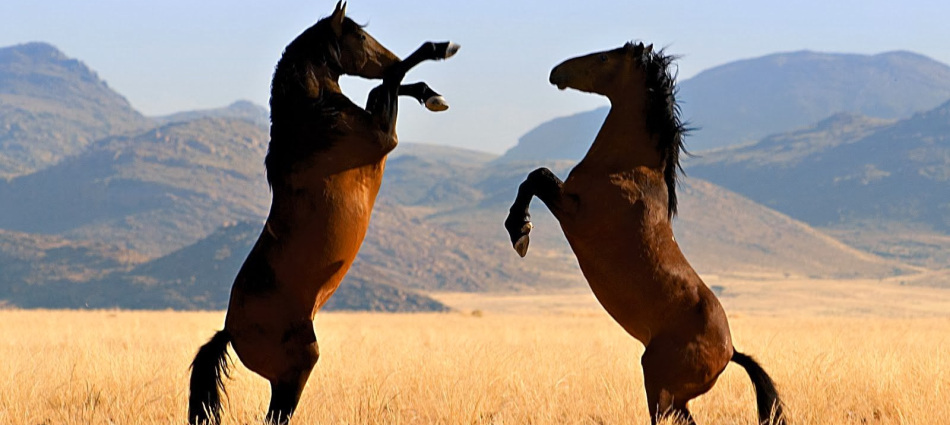
ENDANGERED SPECIES FRIDAY | EQUUS FERUS CABALLUS
This Fridays Endangered Species Post focuses on a sub species of the E. ferus that inhabits the plains of Namibia, Africa. Image: Klein-Aus Vista - E. F. Caballus.
The species (E. ferus) I believe was identified by Professor Carl Von Linnaeus back in 1758 of which identified quite a large number of horses to be precise, however the E. F. Caballus originates from around 1915. Carl Linnaeus born (23 May 1707 – 10 January 1778), also known after his ennoblement as Carl von Linné was a Swedish botanist, physician, and zoologist, who formalised the modern system of naming organisms called binomial nomenclature. He is known by the epithet “father of modern taxonomy”. Many of his writings were in Latin, and his name is rendered in Latin as Carolus Linnæus (after 1761 Carolus a Linné).
E. F. Caballus isn’t listed on the IUCN Red List that I myself can locate (although is endangered). From 1965 the species was listed as (incredibly rare). Then ‘sketchy reports’ state from 1986 to 1996 the species went completely extinct within the wild, there is no evidence to back this claim up though.
From 2008 the species was ‘allegedly’ re-discovered and listed as critically endangered (although as explained there is no criteria on the IUCN Red List relating to this sub-species). Come 2011 populations had somewhat increased slightly placing the species in the band of endangered?. The criteria relating to extinction I am currently looking into as I believe this report ‘could be incorrect’. There is certainly some image evidence (although not proven) that shows a species ‘identical to the Namibian horse’ during the so called extinction period from 1986-1996. However the sub-species has been reported on since the 1940’s.
From what I know the species is a rare feral desert horse of which populations are believed to be near extinction level. Populations are estimated to be between 90-160 mature individuals. Namibia wild horses generally lead healthy life’s although during times of extreme drought (during the summer months) is when the species is normally reported to be struggling, with a number of deaths reported annually.
The origin of the Namib desert horse is unclear, though several theories have been put forward. Genetic tests have been performed, although none to date have completely verified their origin. The most likely ancestors of the horses are a mix of riding horses and cavalry horses, many from German breeding programs, released from various farms and camps in the early 20th century, especially during World War I. Whatever their origin, the horses eventually congregated in the Garub Plains, near Aus, Namibia, the location of a man-made water source.
During the 1980’s the species was virtually eradicated because locals disliked the horses trampling and eating their crops. Fortunately up until the 1980′ the species has lived a virtually hassle free life. Humans rarely if at all bother them, and there is no evidence to prove the species is under threat from hunters, or the African medicine/animal parts trade. Furthermore there doesn’t appear to be any evidence of poaching neither which is good.
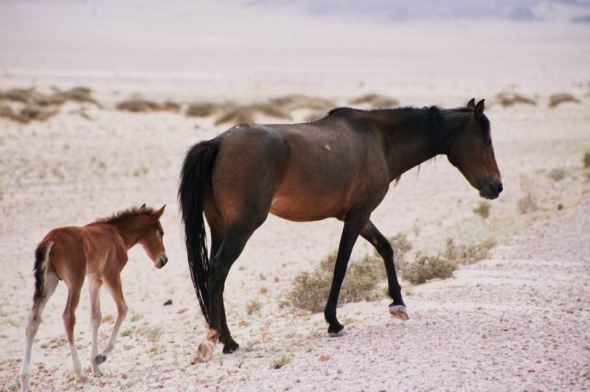
Image: Namibia desert horse and foal.
Namibian wild horses host a number of ‘wild predator threats’ though such as hyenas, blacked backed jackals, and leopards too. Young horses (foals) are normally taken by predators, however adults rarely aren’t.
The harsh environmental conditions in which they live are the main driver of mortality among the Namib desert horse, as they cause dehydration, malnutrition, exhaustion and lameness. Other large plains animals, including the mountain zebra, may have once sporadically utilized the area for grazing during periods of excess rainfall, but human interference (including fencing off portions of land and hunting) have eliminated or significantly reduced the movement of these animals in the area.
The endangered Hartmann’s mountain zebra does exist in the Naukluft Mountain Zebra Park portion of the Namib-Naukluft Park, but their range does not intersect with that of the Namib Desert Horse.
SOURCE: HORSE JUNCTION.
From what I know there is no evidence of wild horses inhabiting anywhere within ‘Southern Africa’, so the theory is these horses may have been imported by the Germans during the last World War, of which after the war the horses were eventually set free to do as they please. While there are numerous speculations and stories - we’ll never truly know where these horses have originated from. Furthermore due to interbreeding genetic testing has proven to be somewhat of a failure too in establishing the true origins of these magnificent beasts.
SOURCE HORSES AND GHOST TOWN CNN.
A further theory although not proven touches on a large vessel carrying thoroughbreds to Australia that unfortunately wreaked near the Orange River. On breaking up the strongest horses are ‘believed’ to have swam ashore to the Garub Plains, the home of the Namib Desert Horse, near Aus, Namibia. As explained though to date there is still no evidence to prove where these horses originated from, moreover all theories haven’t a single scrap of evidence to back such claims up.
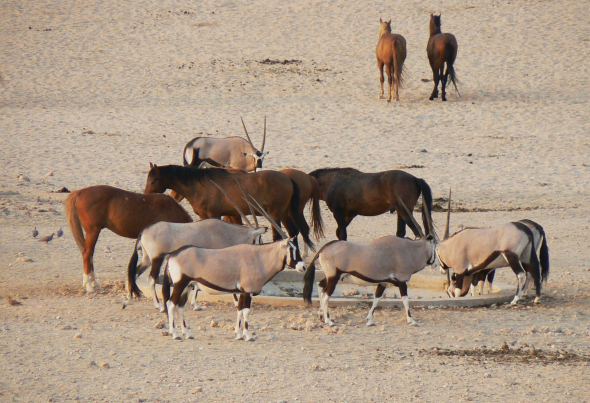
Image: Namibia wild horses drinking at water hole.
One of the biggest threats that could today threaten the wild horses of Namibia is that of water shortages. For now we know the horses normally occupy areas where there is sufficient water holes, large man-made or natural lakes. With drought and climate change becoming more problematic within many Southern African countries its likely we ‘could see species extinction occur in as little as five to ten years’.
All the wild horses in the world, with the exception of a single population, originate from domestic stock. Horses were domesticated on the Eurasian steppes 5,000 to 6,000 years ago, and have been in service to humankind ever since. It was on the horse’s back that civilization advanced. Countries were explored, wars were fought, agriculture and industry progressed at the expense of the horse’s freedom.
The only horse population that was never domesticated, and still exists in its true genetic form, is Przewalski’s Horse or the Mongolian Wild Horse. So extinction could occur very soon simply because the Namibia wild horse’s natural born living instincts haven’t really adapted to the extreme wilds of Africa hence why they are commonly located around man-made or natural water sources, and human settlements?
It was reported this year back in April that drought has been responsible for many species of animals dying due to lack of water and available fresh food sources which has prompted the Namibia Wild Horses Foundation (NWHF) to appeal for funds or good quality grass during this more severe period to see the horses through the winter. NWHF was established in 2012 to monitor the well−being of the horses and to marshal funds for buying feed when the need arises during the drier cycles.
Back in April (2016) the (NWHF) stated there is little grass in the horses’ range as the drought has severely affected the central and southern parts of the country. “The foundation fears that without rain there will be virtually no grass left by the onset of winter and as the horses’ condition further deteriorates, numbers will begin to drop dramatically,” the statement reads. Spring is also now approaching Africa of which we may see further prolonged droughts, and even more deaths.
The foundation also expressed gratitude for all generous contributions for the horses during the past six months. This, it said, has provided supplementary feed – a quarter to a third of the horses’ nutritional requirements — in the form of grass and lucern and protein licks, and will sustain the herd until the beginning of June when the next phase will need to be implemented to ensure their survival; (this period is now over and donations are greatly needed to keep these horses alive). If you’d like to donate to the (NWFH) please click the donate button here: DONATE.
Concerning: The April report also highlighted that some 100 ‘old horses and some fouls’ had sadly perished since the beginning of the drought, which to date leaves exactly 160 mature individuals remaining within the desert of Namibia.
Donations to buy grass or lucern for the horses can be made to Namibia Wild Horses Foundation, First National Bank, current account 62246659489 Klein Windhoek branch ( code 281479) and swift FIRNNANX.
The future is uncertain for the species, in my humble opinion I doubt these horses are going to be inhabiting the desert much longer due to the harsh impacts of climate change increasing every year on the African continent. Furthermore due to the species not really having any ‘natural wild instincts from their ancestors’ they’ll continue to rely on humans just to stay alive. If you’d like to help the species please do so via contacting the Namibian Non-Governmental-Organisation above and donate what you can. Alternatively you can I believe volunteer to help preserve Africa’s only wild horse populations known.
Thank you for reading.
Dr Jose C. Depre PhD. MEnvSc. BSc(Hons) Botany, PhD(NeuroSci) D.V.M.
Master of Environmental, Botanical & Human Science.


